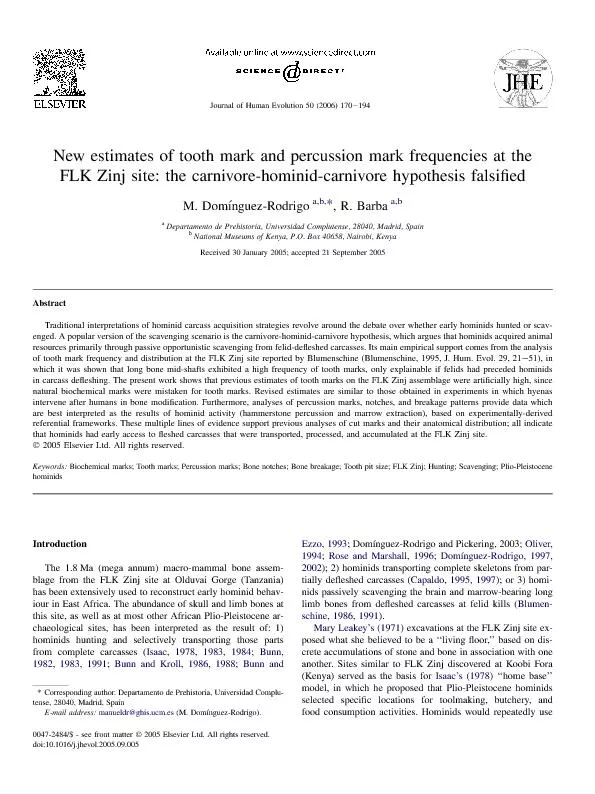/


CorrespondingauthorDepartamentodePrehistoriaUniversidadComplutense28040MadridSpainEmailaddressmanueldrghisucmesMDom ID: 446238
Download Pdf The PPT/PDF document "Newestimatesoftoothmarkandpercussionmark..." is the property of its rightful owner. Permission is granted to download and print the materials on this web site for personal, non-commercial use only, and to display it on your personal computer provided you do not modify the materials and that you retain all copyright notices contained in the materials. By downloading content from our website, you accept the terms of this agreement.
NewestimatesoftoothmarkandpercussionmarkfrequenciesattheFLKZinjsite:thecarnivore-hominid-carnivorehypothesisfalsiÞedM.Domõ,R.BarbaDepartamentodePrehistoria,UniversidadComplutense,28040,Madrid,Spain *Correspondingauthor.DepartamentodePrehistoria,UniversidadComplu-tense,28040,Madrid,SpainE-mailaddress:manueldr@ghis.ucm.es(M.Domõ JournalofHumanEvolution50(2006)170 thesesites,transportingfoodfromtheoriginalprocurementlocationandintentionallysharingitwithothersatthehomebase.ThismodelpresumedthathominidshadsufÞcient(i.e.,primary)accesstomeat.ThisassumptionwasquestionedbyBinford(1981),whoreinterpretedLeakeyÕsoriginal,preliminaryfaunallisttoformaradicallydifferentconclusion.Usingskeletalpartpro-Þles(basedonlyontheelementswithepiphysesreportedbyLeakey)inconjunctionwithreferentialframeworksonboneaccumulationsfrommodernforagersandcarnivores,BinfordarguedthattheOlduvaiGorgesiteswereprimarilynaturalandcarnivore-madeaccumulations.Plio-Pleistocenehomi-nids,heproposed,werethelastandmostmarginalofscav-engersuponthelocalmeatsupply.Atthesametime,Bunn(1982,1983)wasalsocomparingtheFLKZinjassemblageagainstreferentialframeworksthathedevelopedbasedonleopardandhyenadens,aswellasonmodernhunter-gathererhomebases.HisanalysisofthefossilassemblagedifferedfromBinfordÕsintwoimportantways.First,heconsideredalltheshaftfragments,whichareextremelyinßuentialonskeletalpartproÞles,sincecarnivoreswilloftendeletethecancellous(i.e.,epiphyseal)tissueonwhichmostproÞlesarebased(Pickeringetal.,2003).Second,Bunnintroducedthestudyofcutmarksonbonesurfacesasasignatureofhominidbehaviour.BunnÕstaphonomicanalysisofthesiteledhimtoconcludethathominidsattheFLKZinjsitehadprimaryaccesstomeatthroughhunting.TheensuingdebatebetweenBinford(1986,1988)BunnandKroll(1986,1988)lastednearlyadecade.Ultimately,itendedinastalemate,sinceskeletalpartproÞlescouldbeinterpretedasevidenceforeitherprimaryorsecondaryaccesstomeatbyhominids.Binford(1988)alsouseddatafromcutmarkstosuggestthathominidswerescavengingmeat,atleastfrommiddle-sizedanimals.However,hisinterpretationsofcutmarksattheFLKZinjsitewereinevitablyßawed:Þrst,heintentionallyoverlookedthecutmarkdatafromtheFLKZinjarchaeofaunathatBunnandKroll(1986)reportedbe-causehedidnotagreewiththewaythatthemarkshadbeenidentiÞed;second,noexperimentalframeworkforscavengingwasavailableatthattimetosupporthisinterpretationsofcutmarkmorphologyandlocationonbones.TheequiÞnalityposedbyskeletalpartproÞlesledsomeresearchersinthe1980s-90stodevelopexperimentally-basedreferentialframeworks,usingbonesurfacemodiÞcations,tomodelcompetinghypothesesofagentinteraction:carnivoreonly,hominidonly,hominidtocarnivore,orcarnivore-hominid-carnivore(Blumenschine,1988,1995;Selvaggio,1994;Capaldo,1995,1997,1998;Domõnguez-Rodrigo,1997,1999).ThesubsequentanalyticalshiftledtoalandmarkpublicationinBlumenschine,1995)inwhichthehighfrequencyoftoothmarksonthemid-shaftsectionsoflongbonesattheFLKZinjsitewasexplainedbyatriple-stagemodelsupportedbydatafromearlierexperimentswithhuman-andcarnivore-modiÞedbones(Blumenschine,1988Accordingtothismodel,somecarnivores(felids)hadprimaryaccesstocarcasses,removingßeshpartially(Capaldo,1998orcompletely(Blumenschine,1986,1995);hominidshadsecondaryaccess,processingmarrow-bearingbones(reßectedinthepercentageofpercussion-markedbones);Þnally,othercarnivores(hyenids)consumedthegrease-bearingcancellousThiscarnivore-hominid-carnivoremodelwasonlyexperi-mentallyreplicatedonce(Selvaggio,1994),andthesamplesweresmallandheavilybiasedtowardssmallcarcasses.Laterexperiments(Capaldo,1995,1997)providedmorerobustdataforcarnivore-onlyandhominidtocarnivoremodels,sincethesamplesincludedbothlargeandsmallcarcasses.CapaldoÕsre-sultsattestedtostrongravagingofbonebyhyenas,providingtheÞrstempiricalproofinthewildofwhatMareanetal.hadalreadydocumentedamongcaptivehyenas.ThesedatafurtherweakenedthemeritofskeletalpartproÞles,andstrengthenedthevalueofbonesurfacemodiÞcationstudies.ThemodelsbuiltbyBlumenschine,Selvaggio,andCapaldostronglyreliedontoothmarksandpercussionmarksasthemainbonesurfacemodiÞcations,virtuallyignoringcutmarks.YetthecutmarkdatafromFLKZinjoriginallyreportedbyBunnpaintsaverydifferentpicturefromBlumenschineÕsmodel(nguez-Rodrigo,1997,1999);thiscontra-dictionpromptedourreanalysisoftheFLKZinjassemblage.Thecarnivore-hominid-carnivoremodelatFLKZinjreliesonanÔÔanomalousÕÕhighfrequencyoftoothmarksonmid-shafts,presumablyresultingfromfelidshavinginitiallydeßeshedthecarcassesbeforehominidsscavengedthem,sincehyenas,havinglateaccesstobrokenlimbbones,wouldonlymarktheendswhileconsumingtheirgrease.ThetoothmarkfrequencyobservedbyBlumenschine(1995)wasclearlyoutsidetherangeofvariationforboththecarnivore-onlyandhumantocarnivoremodelsdevelopedbyhimBlumenschine,1988).Therefore,theFLKZinjassemblagestoodoutasanoddityneverbeforereplicatedexperimentallyorobservedarchaeologically.Inthepresentstudy,wethoroughlyexaminedsurfacesoflongbonespecimensfromFLKZinj,andfoundthatsomesur-facemodiÞcationswithsimilarmorphologytotoothmarks(asidentiÞedbyBlumenschine)werecreatedbybiochemicalpro-cesses.TheseareoverwhelminglythemostcommontypeofbonesurfacemodiÞcationintheassemblage.TherevisedtoothmarkratesatFLKZinjarefarlowerthanthosereportedBlumenschine(1995),andareevenlessthannew,lowerestimatesobtainedinrecentexperimentswithfelids(nguez-Rodrigoetal.,inpress);theyaremuchclosertothoseobtainedinhuman-carnivoreexperimentsBlumenschine,1988;Capaldo,1995).Additionally,ouranal-ysisoftoothpits,percussionmarks,andnotchesprovidesdatawhich,whencomparedwithexperimentally-derivedreferen-tialframeworks,suggestthathominidshadprimaryaccesstoßeshedcarcasses.Ourmultiplelinesofevidencepointtoasimpleconclusion:carnivoreaccesstotheboneassemblageatFLKZinjwassecondarytobutcheryandmarrowextractionbyhominids,asoriginallyarguedbyLeakey(1971),Bunn(1982,1983),andBunnandKroll(1986,1988).Thisconclu-sionfurtherbuttressestheresultsofearliercutmarkstudiesatFLKZinj(Bunn,1982,1983;BunnandKroll,1986,1988;andinterpretationsinnguez-Rodrigo,1997,2002M.Domõ«nguez-Rodrigo,R.Barba/JournalofHumanEvolution50(2006)170 SampleandmethodsTheanalysisofthelonglimbbonesamplefromFLKZinjwascarriedoutinNovember-December2004attheNationalMuseumsofKenyainNairobi.SpecimenswerecarefullyanalysedforsurfacemodiÞcations,includingcutmarks(tobepublishedelsewhere),percussionmarks,toothmarks,andothernaturalmarks(Tables1and2).Thenumberofboneswithgoodcorticalpreservationanalysedinthisstudy699)isverysimilartothesample(NISPanalysedbyBlumenschine(1995),andsmallerthanthenumberofspecimens(NISP1467)analysedbyBunnandKroll(1986),sinceBunnandKrollincludedboneswithpoorcorticalpreservationandspecimenssmallerthan2cm.ThesampleisalsosmallerthanBlumenschineÕsbecausethosespecimensshowingambiguousmarksthatcouldnotbedistin-guishedaseithertoothmarksorbiochemicalmarks(nwerediscardedtopreventbias.Thedifferenceofsixspeci-mensbetweenBlumenschineÕssampleandoursmightbeac-countedforbydifferentNISPcount,sinceseveralspecimenswithrecentbreakswerecountedasonespecimenbyus.BothBlumenschineÕssampleandoursfocusedonspecimenslargerthan2cmthatshowedgoodcorticalsurfaces.Mostofthespecimensshowverygoodcorticalpreservationbutsur-facequalityisfarfromexcellent.WedeÞneexcellentcondi-tionasthepresenceoforiginalcorticalsurfacesonwhichonlymodiÞcationsmadebyhumansorotheranimalsarepres-ent;thiscontrastswithBlumenschineÕs(1995:28)deÞnitionofexcellentconditionasÔÔpreservingÞnedetailsofmarkmorphology.ÕÕMostofthespecimensatFLKZinjhavebeenaffectedbynaturalprocesses:soil,moisture,andpHcreatedexfoliationandcrackingsimilartothoseobservedatvariousstagesofsubaerialweathering(Behrensmeyer,1978),andbio-chemicalprocessescreatedthemodiÞcationsdescribedbelow.Despitethisbiogenicdamage,thesurfacesareinsufÞcientconditiontopreservethediagnosticfeaturesofpercussionmarks:theshapeofthepit,itslocationwithrespecttobreak-ageplaneandnotches,andmicrostriationsasdescribedBlumenschineandSelvaggio(1988).CutmarksarealsoclearlyidentiÞableanddistinguishedfrommarkscreatedeitherbytrampling/abrasionorbydiggingtools.Inouranalysis,toothandpercussionmarkswereÞrstscru-tinizedunderastronglightbynakedeye;then,thecompletespecimen,notjustthemark,wasexaminedwitha10-15handlensalsounderstronglight.Eachmarkwasindividuallyexaminedanditsfeaturescarefullyconsideredinlightofexperimentally-derivedresearchontheidentiÞcationoftoothandpercussionmarks(Blumenschine,1988;BlumenschineandSelvaggio,1988).Weanalysedbetween5-10bonesperhourandidentiÞedmarksweredouble-checkedbybothauthorstoensureaccuracy.FollowingBlumenschineÕsprocedureandhispublishedlistofbonesbearingtoothmarks,wewereabletolocateallmarksthathereported.ItshouldbestressedthatdespitethedivergentresultsbetweenthepresentstudyandBlumenschineÕs(1995)study,weallfol-lowedthesameidentiÞcationprotocol.Oneofus(MDR)receivedfurthertrainingusingBlumenschineÕsactualisticcollectionofcarnivore-ravagedbonesin1996.Weallagree Table1Samplesizefortoothmarks(TM)andpercussionmarks(PM)usedbyBlumenschineandDomõnguez-RodrigoandBarbaToothmarksSamplesizestudiedbyBlumenschine&Domõnguez-RodrigoandBarbaTMidentiÞedbyDomõnguez-RodrigoandBarba61(16.8%)TMidentiÞedbyBlumenschine255(70.1%)TMhumerus75.9%(44/58)TMfemur84.0%(26/31)TMradius71.7%(43/60)TMtibia69.7%(53/76)TMmetacarpal80.0%(24/30)TMmetatarsal66.7%(24/36)Numberofspecimenswithbiochemicalmarks190(74.0%)PercussionMarksSamplesizestudiedbyBlumenschine&Domõnguez-RodrigoandBarba364PM/percussionnotchesidentiÞedbyDomõandBarba109(29.9%)75(20.6%)Percussionnotches34(9.3%)percusionnotch96(26.4%)PMidentiÞedbyBlumenschine118(32.4%)NoofPMcoincidingwithDomõnguez-RodrigoandBarba48(13.2%)NoofpercussionnotchescoincidingwithDomõnguez-RodrigoandBarba12(3.3%)percusionnotchcoincidingwithDomõnguez-RodrigoandBarba68(18.7%)Numberofspecimenswithbiochemicalmarks190(74.0%) Table2Meanpercentagesoftooth-markedspecimensinrelationtothetotalnumberofspecimensinexperimentalassemblagesandintheFLKZinj,accordingtoboneportion:epiphysis(EPIPH),near-epiphysis(NEP),andmid-shafts(MSH).Analysisof95%CIforsetsofexperimentsareincluded.Theywerecalculatedusingthetdistribution,wheret025isthecriticalvalueoftwithn-1degreesoffreedom.*Blumenschine(1988,1995).**Capaldo(1997).EPIPHNEPMSHALLSmall-sizedcarcassesCarnivoreonly*Mean%10075.069.170.895%CI(-)(0-100)(47.5-90.7)(33.1-100)Hammerstone-to-carnivore*Mean%50.060.715.921.995%CI(0-100)(29.3-92.1)(2.6-29.2)(5.1-38.7)Hammerstone-to-carnivore**Mean%-31.414.919.495%CI-(19.9-42.9)(11.2-18.6)(15.5-23.3)FLKZINJPercent24.023.513.817.3Nomarked/total(12/50)(4/17)(17/123)(33/190)Large-sizedcarcassesCarnivoreonly*Mean%10090.586.587.795%CI(-)(76.5-100)(75.7-97.3)(78.5-96.9)Hammerstone-to-carnivore*Mean%85.739.55.116.495%CI(35.6-100)(8.4-70.6)(0.2-10.0)(10.5-22.3)Hammerstone-to-carnivore**Mean%-48.416.227.095%CI-(40.5-56.3)(10.4-22.8)(22.5-31.5)FLKZINJPercent28.327.79.714.0Nomarked/total(17/60)(15/54)(39/392)(71/506)M.Domõ«nguez-Rodrigo,R.Barba/JournalofHumanEvolution50(2006)170 onthediagnosisofconspicuousandinconspicuoustoothmarksonbonesfrommodernexperimentalassemblages;ourresultsdifferonfossilassemblages,whereothernaturalpro-cesses(i.e.,biochemicalprocesses)areatwork.ToothmarkswereidentiÞedfollowingthecriteriadescribedBinford(1981),Bunn(1981),Shipman(1983),Blumen-schineandSelvaggio(1988,1991BlumenschineandMarean(1993),Blumenschine(1995),andFisher(1995).ToothmarksaredescribedbyBlumenschine(1995:29)ashavingÔÔbowl-shapedinteriors(pits)orU-shapedcross-sections(scores;seealsoBunn,1981)thatcommonlyshowcrushingthatisconspicuousunderthehandlens,andwhich,macroscopically,givesthemarkadifferentpatinathantheadjacentbonesur-face.ÕÕHowever,whenapplyingBlumenschineÕscriteria,iden-tiÞcationofalargeportionofthesampleastooth-markedwasdifÞcultduetothepresenceofbiochemicalmarks,whichcanbedistinguishedwhendiagnosticcriteriaexplainedbelowareapplied.PercussionmarkswereidentiÞedbasedoncriteriaoutlinedBlumenschineandSelvaggio(1988)BlumenschinedescribespercussionmarksasÔÔpits,groovesoriso-latedpatchesofmicrostriations.Pitsandgroovesareusuallyassociatedwithdenselypackedandshallowpatchesofmicro-striationsorientedapproximatelytransversetothelongaxisofthebonethesepatchesofmicrostriationsoccurwithinand/oremanatefromthedepression.Microstriationsalsooccurasisolatedpatches.ÕÕPercussionmarksandtoothmarkscanbeconfused.Blumenschine(1995)claimsthatpercussionmarkslacktheinternalcrushingassociatedwithcarnivoretoothmarks.However,wehaveexperimentallyobservedthatper-cussionmarksobtainedusingmodiÞedhammerstones(i.e.,chopperorchoppingtools)frequentlydisplaymarkswithin-ternalcrushingonbonesurfaces,whichcanoftenbedistin-guishedfromtoothmarksbecauseoftheirangularcontours(workinprogress).ThesetypesofmarksareobservedonbonespecimensfromFLKZinj(Fig.1).UnmodiÞedhammer-stonesalsogenerateasubstantialproportionofmarkswhichmaybeashighas30%withoutstriations,whichmaybemistakenfortoothpitslackinginternalcrushing(workinprogress).Inthepresentstudy,onlymarksthatshowedthedi-agnosticfeaturesasdescribedbyBlumenschineandSelvaggiowereidentiÞedaspercussionmarks.ThelocationsofsurfacemodiÞcationswererecordedbyboneportion,bonesection,andelement.Theboneportionsystem(Blumenschine,1988,1995)dividestheboneintoepiphyseal,near-epiphyseal,andmid-shaftportions.WeusedthissystemonlytoenablecomparisonwithBlumenschineÕsdata.ThebonesectionisamorespeciÞcunitofanalysisnguez-Rodrigo,1997,1999)referringtothepartsofaboneportion:forexample,oneepiphysealboneportioncanbeformedbytheepiphyses,thenear-epiphysis,andasmallpartofthemid-shaft.Thissingleportionwouldhave3differentsections.Thebonesectionsystemhasahigherdegreeofresolutionthantheboneportionsystem,andthere-forestrengthenstaphonomicinterpretations,sinceeachagent.carnivore)modiÞesbonesectionsdifferentlyaccordingtotheiraccess(primary.secondary)(seedetailsnguez-Rodrigo,1997,1999).Finally,bydeterminingelementtype,wecancompareelementsmodiÞedbycarni-voresbyhominids,enablingustobetterdeterminehominidaccesstocarcasses.SpecimenswereclassiÞedasbelongingtotwoanimalsizecategories:smallcarcasses(sizes1and2)andlargecarcasses(sizes3and4)asdeÞnedbyBunn(1982).Mostcarcassesinthelargesizecategoryweresize3.Additionally,toothpitswerealsomeasuredtoidentifythetypeofcarnivore.Marksthatclearlydenotedcarnivoreauthorshipweremouldedusinghighresolutionsiliconeandthenegativesofthemarksweremeasured(breadthandlength)withadigitalhigh-precisioncaliper,followingtheprotocoldescribedbyRodrigoandPiqueras(2003).Pitsizesonshaftsandepiphyseswereanalyzedseparately,sincethesamecarnivorewillleavelargermarksoncancellousbone.Breakagepatternsontheboneassemblagewerealsoana-lysed,sincenotchtypecanpointtotheagentresponsibleformarrowextraction.Notchesaresmall,semi-circularoutlinesinpartofthebreakageplanethatinterrupttheotherwiserec-tilinearoutlineoftheplane.Theyoriginateatthepointfromwhichboneßakesaredetached,creatinganegativescaronthemedullarysurface.Notchesmaybecreatedbycarnivoregnawing(staticloading)orbyhammerstonepercussion(dy-namicloading).CapaldoandBlumenschine(1994)quantiÞed Fig.1.RectangularpercussionmarksonaspecimenfromFLKZinj,probablymadewithachopper.NoneofthemarkswereassociatedwithmicrostriationswhenanalysedusingSEM.Notetheangularcontourofthemarkmadebytheirregularedgeofthehammerstone,which(intheabsenceofmicrostriations)isthebestcriteriafordifferentiatingrectangularpercussionpitsfromthosecre-atedbyteeth.M.Domõ«nguez-Rodrigo,R.Barba/JournalofHumanEvolution50(2006)170 thefrequencyandmorphologyofnotchesexperimentallypro-ducedbythesetwoagents.Theyshowedthatpercussionnotchesaremoreabundantandarebroaderandshallowerincorticalviewthangnawingnotches.Followingtheirprotocol,werecordedtheplatformangleofthenotchaswellasthefol-lowingtworatios:notchbreadthtonotchdepthfromacorticalview,andßakescarbreadthtomaximumnotchdepthonthemedullarysurface.WealsotalliedbreakageplanesandquantiÞedtheanglerangeonalllongitudinalandobliquebreakageplanes.Thephysicalprincipleswhichgovernstone-toolmanufactureapplyequallytothebreakagepatternsofbones;thisapproachwasexperimentallymodelledonbothhammerstone-brokenandcarnivore-gnawedbones(ntaraetal.,inpress)andhasbeensuccessfullyappliedtoarchaeologicalandpaleonto-logicalcontexts(Pickeringetal.,2005).Dynamicloadingthroughhammerstonepercussioncreatesanimpactonbonethatexpands,detachingaßakewitheitheranacuteorobtuseangle,accordingtothedensityoftheboneandtheforceoftheimpact;thebreakageplanewillthereforealsohaveanacuteorobtuseangle.Bycontrast,staticloading(carnivoregnawing)createsßakesandbreakageplaneswhichmorecloselyapproachrightangles.Throughoutourwork,weuseexperimentally-derivedrefer-entialframeworks(referencedthroughoutthefollowingtext)tointerpretthenewFLKZinjdataandtocompareitwiththatofpreviousresearchers.InterpretiveframeworkscanbeelaboratedbyusingethnographicanalogicalobservationsLupoandOÕConnell,2002)orthroughexperimentalrep-lication.Theformerapproachfrequentlydoesnotobservethewholeprocessandreliesonawell-informedinferencethereof.Manyethnographicobservationsjuststudytheendproductofabehaviouralprocess.Theexperimentalapproach,incontrast,requiresthatinordertounderstandthecause-effectrelation-shipinaprocess,itisnecessarytoestablishcontrolmeasuresfromitsbeginningtoitsend,sothatthecause-effectrelation-shipcanbeaccuratelydocumented,andthisisoftenachievedbyreproducingthewholeprocess.Frequenciesofbiochemicalmarks,toothmarks,percussionmarks,andnotchesinboththeexperimentalandfossilas-semblagesweredescribedbyusingmeansand95%conÞ-denceintervals(CIs).Although95%CIscanbeproblematicwhencomparingmanysmallsamples(whichhavealargerCIthanlargesamples),theyhavebeenusedbypreviousresearchersandthereforethesestatisticsenablecomparisonsbetweenpastandpresentwork.BiochemicalmarksinmodernandfossilboneassemblagesBiochemicalmarksonbonearecreatedbyfungiandbacteria,whichformcoloniesonbonesurfaces(Figs.2and3alteringtheunderlyingbone.Thisprocessbeginswithachangeinthebonecolor;subsequently,corticallayersbegintoexfoliate,generatingmarksthatresemblescoresorpits.Thesemarksmaybeshallow(affectingoneortwocorticallayers)ordeep(affectingseveralcorticallayers).Whenbonesbearingfungalcoloniesareburied,carbonateprecipitatinginthesedimentadherestothem,justasitadherestootherorgan-icmaterialsuchasroots,andpreservesthereliefoftheformercolony(Fig.3B),aidingintheidentiÞcationofbiochemical Fig.2.(A)Examplesofexperimentally-createdbiochemicalsurfacemodiÞcationsonmodernbone.ThesemarksappearaspitsandscoreswithdifferentdegreesofmodiÞcation(reßectedindifferentcolortones).AsmallpartofMark1hasbegunexfoliation.Mark3showsaverydarkcoloringofthecorticalsurfaceandMark4showsapowderytexture.Arrowsshowthediagnosticcoloroutline,whichcontrastswiththeinteriorofthemark.(B)Fungifoundonthecorticalsurfaceearlierintheexperiment;thiscolonylikelycreatedoneofthemarksdepictedinFig.2A.Arrowshowsthedarkoutlineunderlyingthefungi.ThelinkbetweenthepresenceoffungiandthebiochemicalmodiÞcationofthecortexcanthusbereliablyestablished.M.Domõ«nguez-Rodrigo,R.Barba/JournalofHumanEvolution50(2006)170 Sharminetal.(2003)undertookacontrolledexperimenttodeterminehowfungiaffectbonestructure,exposingmurinebonesforbetweenoneandtwelveweekstothepathogenicdimorphicfungiCoccidioidesimmitisBlastomycesdermatiti-Histoplasmaspp.,andParacoccidioidesbrasiliensis,andtosomestrainsofdematiaceousfungi(ExophialaFoncecaeapedrosoi).Theauthors(2003:19-20)foundthatÔÔthefungalisolatesexhaustedthearchitectureofcompactcor-ticalbonesbycreatingirregularcrateredandgroovedsurfacesandcausingimpingement[demonstrating]Þlamentousformsandporulationinandallaroundthebonestructure.ÕÕDespitetheshortincubationperiodinthisexperiment,comparedtothemuchlonger-termprocessesaffectingthear-chaeologicalrecord,mostofthefungalstrainsshoweddegreesofinvasivenesstothebone.Notsurprisingly,bonesleftinnaturalenvironmentsoverlongperiodsoftimeshowanevenhigherincidenceofcorticalmodiÞcation.Pieperbrinkmadeobservationsonburiedbonewhichattesttomicrobialattack.Microbesinvadebonecavities,excreteen-zymesandacidsinordertoreleaseusableenergyresourcesfromthebonetissue,andthenconsumethistissue.TheresultisÔÔspeciÞcosteolysis(microscopicalfocaldestruction)ÕÕPieperbrink,1984:241).Biochemicaldamageaffectsbothhistologicalstructureandthecorticalsurface(Marchiafauaietal.,1974;Hackett,1981;Child,1995;Greenlee,1996Theseresultsmustbetreatedwithcaution:experimentally-derivedmodelsforbiochemicaldamageremainincomplete,andwedonotfullyunderstandhowthedamagewhichtakesplaceovermonth-oryear-longtimescalesmaybeappliedtothefossilrecord.However,wehaveoutlinedapreliminarymodelbelow,basedonanexperimentally-derivedreferentialframework,fortheprogressionofbiochemicalbonemodiÞca-tion.Foradoctoralresearchproject(inprogress,underthesupervisionofMDR),20deßeshedanddemarrowedequidandbovidboneswereplacedinaboxforalmost2years(beginningFebruary2003)toassessbonedecayintheabsenceofthehardtocontrolbone-modifyingagentsusuallypresentinsoils(e.g.,pH,microbes,insects).Afterthreemonths,spongystructuresidentiÞedasfungiwereobservedaroundthepatchesofperiosteumthatsurvivedelementprocessing,aswellasonsomebarepatchesofbone(Fig.2B).Insubse-quentmonths,thesestructuresdecayedandwerecompletely Fig.3.SeveralexamplesofbiochemicalmarksinStages1-3onspecimensfromFLKZinj.Blackbarsillustratecross-sectionofthescore.Wheretheyarecom-pletelyrectangular,noscoreexists.(A)Brownlinesonthebonesurfacecreatedbyfungi(Stage1).Theirorientationissimilartothatoftoothscores.(B)Severalelongatedcarbonateformations,underwhichthecortexisabouttoexfoliate(Stage1).(C)Score-shapedlineswithabrownoutlineandcorticaldetewhichsometimesappearexfoliatedwhereaproto-scoreisforming(Stages1-2).(D)Score-shapedmarksandpits,contrastingincolorfromthebonesuTheoriginalcorticallayerispreserved,thoughtheleft-handmarkhasexfoliatedthroughmorethan2corticallayers(whereitsaysnorth)(Stages2-3).(E)DetailofoneofthescoresinFig.3C,showingstainingofthescoreanditscontrastingbrownoutline(Stage2).(F)Anotherbiochemicalscoreshowingoriginalcortexinitsproximalanddistalends,butexfoliationinthemiddle(Stage3).M.Domõ«nguez-Rodrigo,R.Barba/JournalofHumanEvolution50(2006)170 gonebytheeighthmonth,leavingdarkstainsonthespotswheretheyhadappeared,asisobservedatFLKZinj.Thesestainswereeasilydistinguishablefromthesurroundingsur-face.Mostmarksaffectedsurfacecolorbutnotcorticalstruc-ture;however,afew,particularlytheelongatedmarks,beganßakingtheexternalbonecorticallayer.Thisresearchisstillinprogressandwillbemorefullypublishedlater,butthepre-liminarywork(Fig.2)clearlyillustratessimilaritiesbetweenthesemarksandthoseintheFLKZinjfossilassemblage.Thebiochemicalmarkingprocessisdescribedinthefollowingfour-stagemodel:Stage1.Theearliestsignsofmicrobialattackappearasirregularlinesofdiscolorationonthebonesurfacethatmayintertwineorappearisolated.Thesemaybeaccompaniedbyagreenish/whitepowderymatrixonthesurfaceresponsibleforthecolorchangeunderneath(Fig.3).Theinitialcolorchangecontrastswiththesurfacecolor:thelinesaredarkinbonesthathavepreservedtheiroriginalcolor,andlightinbonesdarkenedbydiagenesis.Atthisstagethemarkscannotbeconfusedwithtoothmarks,sincetheexternalcorticallayeroftheboneisintactandnogroovehasformed.Stage2.Thecomponentsofthematrixoverlyingthebonesurfacestartmodifyingtheuppermostcorticallayer.Changesinthesurfacetextureandsomemicro-exfoliationappear.Sincefungiformcolonies,theyspreadbothlongitudinallyandradially(Figs.3and4).Therefore,whentheymodifythecor-ticallayers,theycreatescoresandpits,whichatthisstageareextremelyshallowandareoutlinedwithacolorthatcontrastswiththesurroundingbone.Insomecases,theinternalsurfacesofthesemarksshowmicro-ßaking,whichisdistinctivefromtheinternalcrushingoftoothmarks.Themicro-ßakingmayappearasshallow,separatepits.Theseareclearlydistinctfromtoothscores,whichareformedwhenacarnivoretoothcuspcrushesanddragsalongthebonesurface,evenlyliftingandcuttingthroughdifferentcorticallayers.Stage3.Biochemicalmarksatthisstagemayappearin-completelyformed.Onepartofanincipientgroovemaypre-serveitsoriginalcortexshowingadistinctcolorthatdiffersfromthesurroundingsurface,buthavingnodepthyetanotherpartofthegroovemayalreadybedeepintothecorti-callayers,duetoßakingandcorticalexfoliation(Figs.3and4).Thedifferenceofthisstagefromthepreviousoneisthatthebiochemicaldegradationofthebonenowaffectssev-erallayerswherescoringappears.Stage4.Bythisstage,theuppermostcorticallayershavebeenpenetrated,creatingpitsorscoresthatcouldbemistakenforatoothmarkintheabsenceofadistinctoutlinecoloringFig.5).However,sometoothandbiochemicalscorescanbedistinguishedbytheirshape,directionality,anddegreeofsymmetry,asdescribedbelow. Fig.4.BiochemicalmarksinStages2-4onspecimensfromFLKZinj.Blackbarsillustratecross-sectionofthescore;wheretheyarecompletelyrectangular,noscoreexists.(A)BonemodiÞedbyseveralbiochemicalmarks;themainscoreisshownwithcross-sectionsatbothends(pointsÔÔaÕÕandÔÔbÕÕ),withtheoriginalcortexpreservedatoneendbutexfoliatedattheother(Stage3).(B)PointÔÔaÕÕshowsabrownline,thebeginningofcortexdeterioration(Stage1);ÔÔbÕÕandÔÔcÕÕshowtwoendsofaproto-score,withbrownoutlineandtheoriginalcortexpresent(Stage2);ÔÔdÕÕandÔÔeÕÕshowanincompletebiochemicalscorewhichpreservesoriginalcortexatoneend(ÔÔdÕÕ),andhasalreadyformedagrooveattheother(ÔÔeÕÕ)(Stage3).(C)Apitwhichstillpreservessomeofthecarbonatewhichorig-inallycreatedthemark(ÔÔbÕÕ),andthemarkitself(ÔÔaÕÕ).(D)PointÔÔaÕÕshowsapitcreatedbysuccessiveexfoliation,withitsdiagnosticbrownoutline(Stage4);ÔÔb,ÕÕÔÔc,ÕÕandÔÔdÕÕshowscoreswithirregularoutlines,createdbyindependentepisodesofexfoliation(Stages2-3).M.Domõ«nguez-Rodrigo,R.Barba/JournalofHumanEvolution50(2006)170 Mostbiochemicalscoresshowanirregularshapewithawindingoutline,followingtheinitialformationofthefungiFigs.4Aand5E);toothscoresarealmostalwaysstraight.Occasionally,thebiochemicalscoresmayalsobewide,straightgrooves.However,thewidthofbiochemicalscoresvariesalongitstrajectory(Fig.6),whichisnotthecasefortoothscores,wherethetoothcuspcreatesagroovewithhomogeneouswidth.Thegroovemaybecomewiderasthetoothcuspcrushesdeeperintotheboneandnarrowerasthetoothcuspmovesupwardsandisremovedfromthebone,butineithercase,thewidthfromthelongitudinalaxisofthemarkissymmetrical.Flakingorexfoliationmayformonbothsidesofthetoothscore,sincecarnivoreteethexertuniformpressureonbothsidesofthemark;inbiochemicalscores,exfoliationsaremorerandom.Finally,toothscoresareusuallyperpendicularoratobliqueanglestothemainaxisoftheboneastheresultofcarnivoresdraggingtheirteethtransversallytotheshaft;toothscoresthatareparalleltothelongaxisoftheboneareratherexceptional.However,thisorientationoccursfrequentlyinbiochemicalscores.Thesetraitscanbeusedtodifferentiatebiochemicalandtoothmarks.Occasionally,however,abiochemicalmarklosesitsdistinctivecolorcontrastthroughdiagenesisandcannotbedistinguishedfromatoothmarkintheabsenceofotherdiag-nosticfeatures.Inthiscase,especiallywhenthesemarksap-peartogetherwithotherbiochemicalmarks,itisimpossibletoruleoutthatthesupposedtoothmarksarenotbiochemicalmarks.Forthisreason,weusethecontextualapproachtoensurecorrectidentiÞcationoftoothandbiochemicalmarks.ThecontextualapproachtobonesurfacemodiÞcationstudieswasintroducedatSwartkransMember3(Pickeringetal.,2004,inpress),wherecutmarksweresafelyidentiÞedwhentherewerenosignalsonthebonethatwouldindicatethatthemarkswerenatural(microabrasion,randommicro-striations,orexfoliationsbysedimentfriction).NomarkwasidentiÞeduntilthewholespecimenhadbeenanalysedandthesuperÞcialfeaturesweretakenintoaccount.Thecontextu-alapproachisessentialforthecorrectidentiÞcationofbonesurfacemodiÞcations,giventheoverlappingsignaturesofdif-ferenttaphonomicprocesses.BiochemicalmarksintheFLKZinjassemblageUsingthecontextualapproach,weidentiÞedtoothmarksonlywhentherestofthesurfacedidnotshowanybiochemicalmark,orshowedcleardifferencesbetweenthetoothmarkand Fig.5.BiochemicalmarksinStages3-4onspecimensfromFLKZinj.Scoresshowirregular,increasinganddecreasingwidth(A,B),andfollowtheshapecolonieswithirregularpits(C).(D)Biochemicalpitswhichcanbedifferentiatedfromtoothmarksbasedoncontrastingcoloroutlineandinteriorexfoliation.(E)Extremeexampleofmultiplebiochemicalscoreswithadendriticappearance. Fig.6.RadiusshaftfromFLKZinjshowingpercussionmarks(denotedbyar-rowsonrightandleftsides)andaÔÔtypicalÕÕexampleofatoothscorefromtheFLKZinjsite(arrowinthemiddle)aspresentedbyBlumenschine(1995:35,Fig.1D),whichisinfactabiochemicalmark(seeFigs.7and8M.Domõ«nguez-Rodrigo,R.Barba/JournalofHumanEvolution50(2006)170 thebiochemicalmark.Differencesareclearestwhenthebio-chemicalmarkisinitsearlieststages(1-3);biochemicalmarksinStage4mustshowcleardiagnosticfeatures.Speci-menswhosemarkswereambiguous(n26)wereleftoutofthesampleanalysed(n699).BiochemicalandtoothmarkswerethusconÞdentlyidentiÞed.MostoftheÞguresusedhere(Figs.3-8)toillustratebiochemicalmarksarespeci-mensfromFLKZinjpreviouslyidentiÞedastoothmarksbyBlumenschine(1995).Forexample,Figs.6-8showaspecimenBlumenschine(1995:35,Fig.1D)presentedasaclearexampleofatoothmark.Acloserinspectionrevealsthefollowingdistincttraitsofbiochemicalmarks:1.Thescoreisextremelyshallow.Itwascreatedbyremov-ingthetopcorticallayerofthebonesurface.Theinteriordoesnotshowthetypicalcrushingoftoothscores,butrathershowspartialßakingandexfoliation,occurringinseveralseparatepatches.2.Theoutlineofthescoreisirregularandasymmetrical,withßakingoccurringrandomlyoneachsideofthescore.3.Thescorewidthisirregular,alternatingincreasingandde-creasingbreadth.Thiscontrastswiththehomogenouswidthtypicaloftoothscores.4.Thereisaclearoutlinearoundthescorewhichisadistinctcolorfromthesurroundingbonesurface.MatchingthespecimensanalysedbyBlumenschineandourselveswasnoteasy,sincewehadcataloguenumbersthatdonotappearinhislistandviceversa.Thiswasalsosome-timesduetoambiguityincataloguingonthetagsortodoublecataloguing;additionally,severaldozenspecimenshadthesamecataloguenumber.Furthermore,althoughBlumenschineclaimedtouseonlyspecimenswithancientbreaks,somespecimensinhislistlabelledasÔÔa,ÕÕÔÔb,ÕÕandÔÔcÕÕactuallybelongedtoasingle,recentlybrokenspecimen.Somenum-berswithoutlettersinourlistcoincidewithnumberswithlet-tersinhislist,indicatingthatwebothlookedatthesamespecimen.However,toavoidmismatching,wecomparedonlythosespecimensthatwerecataloguedidenticallyinbothlists(n364).ThissampleissufÞcientlyrepresentative Fig.7.ThescoredepictedinFig.6atahighermagniÞcation(left)andthrougha3DÞlter(right).Theinteriorhasbeenexfoliatedbutpreservesmuchoftheoriginalcortexandmostofthesecondcorticallayer.Thisshowsthatthegroovewascreatedbyexfoliationofthesurfacelayer,andrefutesthatatoothcreatedthemark. Fig.8.(A)SEMphotographofthescoreshowninFigs.6and7.Thescorealternatesincreasinganddecreasingwidth,creatinganhourglassshape,indicatingthatthisisnotatoothmark.ÔÔ1ÕÕshowsfossaethatappearinthescore.ÔÔ2ÕÕshowsthatthescorehasastep-shapedoutlinecreatedbytheexfoliationoftheuppercorticallayer.ÔÔ3ÕÕshowsthattheoriginalsurfacestilloccursinpatchesinthemiddleofthescore.(B)ThesamescoreunderhighermagniÞcation.Thefossae(ÔÔ1ÕÕ)showßat,unmodiÞedsurfacesandsteppedoutlinescausedbytheexfoliationofthecorticallayer.(C)Toothmarkscorefromamodernexperimentalas-semblage,inwhichadeep,smooth,U-shapedgroovecanbeseen.Thescoreshowsapolishedsurfaceandhomogeneouswidthalongthegroove.Thesetraitsclearlycontrastwiththebiochemicalscore.M.Domõ«nguez-Rodrigo,R.Barba/JournalofHumanEvolution50(2006)170 oftheidentiÞcationfrequenciesandcriteriausedinbothstud-ies;these364specimenshavegoodcorticalpreservationandwereanalysedbothbyBlumenschineandbyourselves.Ofthissample,lessthan20%ofthosespecimensidentiÞedasÔÔtooth-markedÕÕbyBlumenschinewereidentiÞedthesamebyus(Table1).InBlumenschineÕsÔÔtooth-markedÕÕsample(70%ofthesampleof364specimens),74%ofthespecimensalsobearbiochemicalmarksinStages2-4.Thereisacorre-spondencebetweenthepresenceofnaturalbiochemicalmarksBlumenschineÕs(1995)identiÞcationoftheseastoothmarks.Thedistributionoftoothmarksbyelementtyperevealsfurtherinconsistenciesbetweenthetwostudies(Table1Toothmarks(asidentiÞedbyBlumenschine)onmetapodialsareveryabundant,closetothemeanforcarnivore-Þrstscenar-ios(Blumenschine,1988).Butahypotheticalfelidstageofcarcassdeßeshingwouldhaveleftalmostnomarksontheseelements,sincetheyareabandonedunmodiÞedbyfelidsmostofthetime(Brain,1981;Domõnguez-Rodrigoetal.,in).Furthermore,aswillbeshownbelow,mostofthebones(includingmetapodials)havebeenfracturedbyhominids.Theresultingmid-shaftfragmentswouldhaveprovidednonutri-tionalresourcesforscavengingcarnivores.ThehighincidenceofÔÔtooth-markedÕÕmid-shaftspecimenswasthereforealientoourunderstandingofcarnivoremodiÞcationofbones.Theconfusionisresolvedbytherevisedtoothmarkfrequenciesonmetapodials(Table3),whichindicatethatasubstantialamountofbiochemicalmarksweremistakenfortoothmarksbypreviousresearchers(Blumenschine,1995;andinterpreta-tionsinSelvaggio,1994;Capaldo,1995,1997).Thehighpres-enceofbiochemicalmarksatFLKZinjisnotanomalous.InheranalysisofOlduvaiBedsIandII,Cushing(2002)remarksthatbiochemicalmarksarepresentonbonesfromalmosthalfoftheoccurrencessampledintheGorge.ToothmarkanalysisbyboneportionByrestrictingtheidentiÞcationoftoothmarkstospecimenswithnoambiguousorconfoundingbiochemicalmarks,ouranalysisoftoothmarksusingBlumenschineÕs(1988)bonepor-tionsystemrevealsacompletelydifferentpicturefrompreviousanalyses.Inthefollowinganalysis,wecompareourdatafromFLKZinjwithexperimentally-derivedreferentialframeworksdevelopedbyBlumenschine(1988,1995)Capaldo(1995)forhuman-carnivoreandcarnivore-onlymodels.Table2Figure9showthedistributionoftooth-markedspecimensintheZinjassemblagebyboneportion.Insmall-sizedcarcasses,theFLKZinjlimbbonesaretooth-markedatsimilarrates(17.3%)tothoseinhuman-to-carnivoreexperiments.Thefre-quencyofmid-shaftfragmentsbearingatleastonetoothmarkisverylow(13.8%),alsocloselymatchingthepercentagesobtainedinhuman-to-carnivoreexperiments.Near-epiphysealspecimensaretooth-markedatverylowrates,betweenhalfofthemeanfrequencyreportedbyBlumenschine(1988,1995)andabout25%lessthanthemeanfrequencyreportedbyCapaldo(1995)(bothforhuman-to-carnivoreexperiments),butwithintherangeofvariationreportedbybothauthors.Epiphysealfragmentsaretooth-marked50%lessthaninhuman-to-carnivoreexperiments.Insum,globaldistributionoftoothmarksatFLKZinjaredistinctfromthoseobservedincarnivore-onlymodels.Longbonesfromlarge-sizedcarcassesarealsotooth-markedslightlyless(14%)thaninhuman-to-carnivoreexperi-ments.Only9.7%ofmid-shaftspecimensaretooth-marked;thisisveryclosetothepercentageobtainedforhuman-to-carnivoreexperimentsandisfarfromtheexpectedpercentage(86.5%)foracarnivore-Þrstscenariorequiredbythecarni-vore-hominid-carnivorehypothesis(Blumenschine,1995Near-epiphysealfragmentsaretooth-markedabout30%lessthanthemeanfrequencyforBlumenschineÕshuman-to-carni-voreexperimentalset,andonlyonepointoutsidehisrangeofvariation.Aswasthecasewithsmallcarcasses,epiphysealfragmentsaretooth-markedlessoftenthaninanyexperimen-talassemblage.Thelowfrequencyoftooth-markedepiphysealandnear-epiphysealspecimensisnotsurprising.Intensiveravagingofbonebyhyenids,asreportedbyBlumenschine(1988),Capaldo(1995,1998),andnguez-RodrigoandPickering,isusuallyreßectedinasubstantialamountofmoder-atetointensivefurrowingintheepiphysealfragments.AtFLKZinjepiphysesarefairlycomplete,andonly3outof110epiphysealfragments(2.7%)showclearsignsoffurrowing.Furthermore,furrowingwasobservedinonly3ofthesampleof59completeepiphysesthatwestudiedforbiometricpurposes(workinprogress).Thissuggestsverymildhyenidbonemod-iÞcationcomparedtoexperimentalassemblages.Thereasonmaylieinthewayresearchersconstructexperimentalmodels.Experimentswithfewbones,oftenfromasinglecarcass,createapaucityoffoodthatmayresultinfarmoreintensivedamagethanwhenplentifulresourcesareavailableforscav-enging,aswasthecaseatFLKZinjwherebonesfromseveral Table3Percentageoftooth-markedspecimensattheFLKZinjaccordingtoelementtypeandbonesection.Numbersinparenthesesare:numberoftooth-markedfments(numerator)andtotalnumberofspecimensofeachcategory(denominator).HumerusRadiusMetacarpalFemurTibiaMetatarsalSmall-sizedcarcassesENDS30.0(4/13)16.6(1/6)23.0(3/13)14.2(1/7)37.5(3/8)16.6(2/12)SHAFTS13.6(3/22)18.7(3/16)4.7(1/21)14.2(2/14)22.8(8/35)6.2(2/32)Large-sizedcarcassesENDS50.0(10/20)42.1(8/19)10.0(1/10)15.3(2/13)20.0(1/5)14.2(1/7)SHAFTS14.6(11/75)12.8(5/39)14.2(2/14)5.7(3/52)15.5(12/77)5.2(1/19)M.Domõ«nguez-Rodrigo,R.Barba/JournalofHumanEvolution50(2006)170 carcasses(includingmanyaxialelements)wereavailable.Lessintenseravagingwouldhaveresultedinalowerrateoftooth-markedepiphysealandnear-epiphysealfragments.ThefrequenciesoftoothmarksatFLKZinjaredissimilarfromthosegeneratedbycarnivore-Þrstexperiments,andthusrefutethecarnivore-hominid-carnivorehypothesis.Instead,thefrequenciesareverysimilar(especiallyformid-shaftspecimens)tothoseobtainedinhuman-carnivoreexperimentassemblages,whereasthefrequenciesreportedbyBlumen-schine(1995)felloutsidetherangesofvariationforallexper-imentalassemblages.ToothmarkanalysisbyboneelementandsectionAtotalof496bonespecimens(513ifincludingulnae)wereidentiÞedtooneofthesixmarrow-bearinglongbones(humerus,radius,metacarpal,femur,tibia,metatarsal).Someboneswererepresentedbymorethanonesection(e.g.,ashaftthathadbothnear-epiphysealandmid-shaftsections),andthusatotalof549sections(excludingulnae)arerepresentedinthisanalysis.SectionswereclassiÞedintoends(containingeitherepiphysealsectionand/ornear-epiphysealsection)andshafts.DatainTable3showthatendsappearmorehighlytooth-markedthanmid-shaftsforbothcarcasssizes.Inmostcases,theshaftsectionsofsmall-sizedcarcassesaremorehighlytooth-markedthanthosefromlargeranimals.Tibiashaftsinbothcarcasssizesarethemostcommonlytooth-marked,whilemetapodialsaretheleastaffected.Humeri(forbothcarcasssizes)andradii(forlargecarcasses)showatoothmarkdistributionthatmatcheshuman-carnivoreexperiments,inwhichepiphysesarehighlytooth-markedandmid-shaftsshowalownumberoftoothmarks(schine,1995;Capaldo,1998).Nomid-shaftfromanyelementshowstoothmarkfrequenciesdifferentfromthosereportedforthesamebonesectioninhuman-carnivoreexperimentsBlumenschine,1988,1995;Capaldo,1995).Thisfurtherreinforcestheinferencesdrawnfromtheanalysisbybonepor-tionpresentedabove.ThepreciselocationsoftoothmarksoneachsectionandelementarealsosigniÞcant.Figures10and11showthatmosttoothmarksclusteraroundlongboneends.Mosttooth-markedmid-shaftsarealsomarkedmoretowardstheirends;ifwedividethemid-shaftinto3parts,themiddleseg-mentisnearlydevoidoftoothmarks.Thisappliestoeverymeat-bearingbone.Thisdistributionwouldnotbeexpectedifacarnivorehadpreviouslydeßeshedthesebones.Thecon-centrationofmarkstowardstheendsofbonescorroboratesthehypothesisthatcarnivores(verylikelyhyenas)intervenedonlyinthegreaseextractionphase,i.e.,afterhominidshaddis-cardedthebones.AnalysisoftoothpitsizesandattributiontocarnivoretypeToothpitsize(lengthandbreadth),consideredtogetherwithotherlinesofevidence,canhelpdistinguishthetypesofcarnivoresinvolvedinthemodiÞcationofcarcasses.AppendixCshowsthespecimensthatwereusedforthestudyoftoothpitsize.Althoughmosttoothmarksinourtotalsamplewerescores,referentialframeworksestablishedbynguez-RodrigoandPiqueras(2003)suggestthattoothpitsarebetterthanscoresfordiscriminatingamongdiversecarnivoregroups.Therefore,onlypitsweremeasuredhere.Small-sizedcarnivoresandintermediate-sizedfelids(leop-ardandcheetah)canbedifferentiatedfromlargercarnivores(hyenaandlion)bytoothpitsizesinbothcancellousandcor-ticalbone.Atoothpitsizerangeisusedtofurtherdifferentiateamongcarnivoretaxa.ThisrangeequalsthemeanplusoneSDoftoothpitsizes;rangeshavebeenmeasuredforspeciÞccar-nivoretaxainbonemodiÞcationexperimentsconductedbynguez-RodrigoandPiqueras(2003);thesizerangesreportedinthisstudywillbeusedasareferentialframeworkfortheFLKZinjdata.Giventheambiguityofsomeoverlap-pingsizeranges,studyingbothtoothpitsizesandbonefurrowingintensityintandemprovidesamoresecureidentiÞ-cationofthecarnivoresinvolved. Fig.9.Distributionofthe95%CI(conÞdenceinterval)offrequencyoftooth-markedspecimensforeachboneportioninexperimentalassemblagesandintheFLKZinjsite.C,Carnivoreonly;Hc,Hammerstone-to-carnivore(Blumenschine,1995);Hc*,Hammerstone-to-carnivore(Capaldo,1997);Zinj,FLKZinj.EPI,epiph-yses;NEP,near-epiphyses;MSH,mid-shaft.M.Domõ«nguez-Rodrigo,R.Barba/JournalofHumanEvolution50(2006)170 ToothpitsizesoncorticalsurfacesofboneshaftsfromFLKZinj(Fig.12)seemtodisplaythesizerangeexhibitedbyhy-enids.Themeanvalueisclosertothatobtainedforhyenidsthantoanyothertypeofcarnivore,andtherangeisbothtoolargeforintermediatefelids(leopardandcheetah)andtoosmallforlions.Thedistinctionbetweenhyenasandlionsisnotveryclear,butitisobviousthatthetoothmarksonshaftsweremadebyalargecarnivore.Thiscontrastswiththedataobtainedfromcancelloustissue,wherethetoothpitsizerangeoverlapswithseveralcarnivoretypes.Combiningallcarcasssizes,themeanvalueandtherangearelargerthanthosereportedforleopardandcheetah,andtheyoverlapwiththosereportedforlargecarnivores(hyenaandlion)andsomeintermediatecarnivores(otherthanleopardandchee-tah).Whenseparatedbycarcasssize,thepitsizesforcancel-loustissuefromlargecarcassesarewithintherangereportedforbothlargeandintermediatecarnivores.Marksoncancel-loustissuefromsmallcarcassesexhibitamuchwiderrangeofvariation,whichsuggeststhattheyaretheresultofhyenainterventionoracombinationofhyenidsandintermediatecarnivores.Theseinterpretationsmustbetakencautiously,sinceexperimentally-derivedreferentialframeworksareimperfect.Theexperimentsconductedformeasuringsizeoftoothpitscreatedbyhyenasweresmall,withfewbones,heavilyravagedbyhyenas.Furrowingwasfrequentandtoothmarksconspicuous.Aswehavenotedabove,mostFLKZinjepiphysesarefairlycompletewithalmostnofurrowingpreserved.ThissuggeststhatifhyenasmodiÞedthisfossilassemblage,theyleftfarmoreinconspicuoustracesthanthoseseeninexperiments.GiventhatepiphysesaremarginallymodiÞedbycarnivores,theyarenotrobustindicatorsofcarnivoretype.Rather,thesizerangesoftoothpitsonshafts(corticaltissue)seemtobemoreindicativeofcarnivoretype.SelvaggioandWilder(2001)reporteddataontoothmarksizesforawidevarietyofcarnivoresandmadeinterpretationsaboutFLKZinj.TheyobservedthattheÔÔmeanareaoftoothpitsoncancellousboneintheFLKZinjsampleissimilartothoseinßictedbyhyenasandlions,ÕÕandthatÔÔforcorticalbone,theZinjsampleismostsimilarinareatopitsinßictedbycheetahs,leopards,andspottedhyenasÕÕ(SelvaggioandWilder,2001:467).Accordingtothesedata,carnivoreinvolve-mentatFLKZinjcouldbetheeffectof:1)hyenaspost-ravag-ingbonesabandonedbyhominids;or2)medium-sizedfelidsdeßeshingcarcasses,followedbydemarrowingbyhominids,andÞnally,hyenasravagingthediscardedassemblage.Inherearlierstudy,Selvaggio(1994)didnotdistinguishbio-chemicalmarksfromthoseinßictedbycarnivores,andhermeasurementsinthelaterpublicationprobablyinclude Fig.10.Anatomicaldistributionoftoothmarksonhumerus,femur,radio-ulna,andtibiafromlargecarcasses.LettersandnumbersindicatespecimennumberfromtheFLKZinjassemblage.BonesareredrawnfromPalesandLambert(1971)M.Domõ«nguez-Rodrigo,R.Barba/JournalofHumanEvolution50(2006)170 specimensofbothtypesandarenotusefulforcarnivoretypeattribution.ThepresentanalysisshowsthatwhensecurelyidentiÞedtoothpitsonshaftsaremeasured,thesizerangeistoolargeforintermediatecarnivores;rather,thedatasuggestthathyenascreatedthepits.Insum,toothpitsizecannotbeusedtosupportthecarnivore-hominid-carnivoremodelasarguedbySelvaggioandWilder(2001)PercussionmarksbyboneportionDatainTable1showthatthefrequenciesofpercussionmarksidentiÞedbyBlumenschine(1995)andbyusareverysimilar.BlumenschineidentiÞedpercussionmarksasthoseinwhichmicrostriationscouldbeobserved.However,weobservedthathisidentiÞcationofpercussionmarksat Fig.11.Anatomicaldistributionoftoothmarksonhumerus,femur,radio-ulna,andtibiafromsmallcarcasses.LettersandnumbersindicatespecimennumberfromtheFLKZinjassemblage.BonesareredrawnfromPalesandLambert(1971) 0124mm 0123456mm 02mm 024681012hyenahyena*baboonjackaldoglionlion*leopard*cheetah*Zinj smallZinj largehyenahyena*baboonjackaldoglionlion*leopard*cheetah*Zinj smallZinj largehyenahyena*baboonjackaldoglionlion*leopard*cheetah*Zinj smallZinj largehyenahyena*baboonjackaldoglionlion*leopard*cheetah*Zinj smallZinj largemm Fig.12.Distributionofmeansplus1standarddeviationofbreadthandlengthmeasuresofpitsfromtheFLKZinjassemblage.Measuresaregivenseparatelyforepiphysesandshafts.Meansplusa1standarddeviationrangearealsoprovidedforexperimentalassemblagescreatedbydifferentcarnivoretypes(seedatainnguez-RodrigoandPiqueras,2003).*DatafromSelvaggio(1994)M.Domõ«nguez-Rodrigo,R.Barba/JournalofHumanEvolution50(2006)170 FLKZinjalsoincludedpercussionnotches;somespecimensidentiÞedbyBlumenschineasbearingpercussionmarksdidnot,uponcloserinspectionbyus,showasinglepercussionorbiochemicalmark,butonlyapercussionnotch.Blumen-schineÕspercussionmarkfrequenciesthereforelumptogetherthesedistinctbonemodiÞcations,whichheidentiÞedsubjec-tively.QuantitativemethodsforidentifyingnotcheswerelaterdevelopedbyCapaldoandBlumenschine(1994),buttheyhavenotbeenappliedtoFLKZinjuntilthepresentstudy.Thefrequenciesofpercussionmarks(i.e.,thosegeneratedbyhammerstonesandmostlyshowingmicrostriations)thatweidentiÞedintheassemblageareshowninTable4Fig.13.Inthefollowinganalysis,wecompareourdatawithexperimentally-derivedreferentialframeworksdevelopedbyBlumenschine(1988,1995)Capaldo(1995)forhuman(hammerstone)-onlyandhuman-carnivoremodels.Forbothcarcasssizes,thefrequencyofpercussionmarksiswithintherangeforhuman-to-carnivoreexperiments.Insmallcarcasses,frequenciesofbothpercussionmarksaloneandpercussionmarksplusnotches(whichwepresenttoenablecomparisonwithBlumenschineÕsdata)aresimilartothemeanfrequencyofpercussionmarksfromhammerstone-onlysamples.Inlargercarcasses,thefrequencyofpercussionmarksissimilartothatfromhammerstone-onlysamples,exceptfornear-epiphysealfragments,whichexhibitalowfrequencyofpercussionmarks,evenwhennotchesareincluded.Thisdifferentfrequencyforthisboneportioncouldbeexplainedifsomespecimenswithverylittlecancelloustissueonthemedullarysurfacewerein-cludedbyusinthemid-shaftsample,whichmightexplaindifferencesbetweenBlumenschineÕsandournear-epiphysealsamplesize.Thatirregularityaside,theremainingbonepor-tionsfromlargecarcasseswithpercussionmarksandnotchescloselymatchthefrequenciesderivedfromhuman-carnivoreexperiments.ThisshouldtheoreticallysupportBlumenschineÕsclaimthatmostlongbonesatFLKZinjwerebrokenbyhom-inidsduringmarrowexploitation. Table4Meanpercentagesofpercussion-markedspecimensinrelationtothetotalnumberofspecimensinexperimentalassemblagesandintheFLKZinj,accordingtoboneportion:epiphysis(EPIPH),near-epiphysis(NEP),andmid-shafts(MSH).Analysisof95%CIforsetsofexperimentsareincluded.Theywerecalculatedusingthetdistribution,wheret025isthecriticalvalueoftwithn-1degreesoffreedom.*Blumenschine(1988,1995).**Ca-paldo(1997).EPIPHNEPMSHALLSmall-sizedcarcassesHammerstoneonly*Mean%54.443.326.636.695%CI(35.7-73.1)(0-91.6)(13.1-40.1)(26-47.2)Hammerstone-to-carnivore*Mean%25.017.715.931.195%CI(0-100)(0-35.9)(2.6-29.2)(17.0-45.2)Hammerstone-to-carnivore**Mean%-30.223.629.695%CI-(18.9-41.5)(18.4-28.8)(23.2-36.0)FLKZINJ(onlyPM)Percent20.023.522.722.1Nomarked/total(10/50)(4/17)(28/123)(42/190)FLKZINJ(PMandestimatedpercussionnotches)Percent26.029.437.317.3Nomarked/total(13/50)(5/17)(46/123)(33/190)Large-sizedcarcassesHammerstoneonly*Mean%75.010033.350.095%CI(-)(-)(-)(-)Hammerstone-to-carnivore*Mean%35.745.520.626.095%CI(0-98.8)(3.2-87.8)(6.4-34.8)(8.6-43.4)Hammerstone-to-carnivore**Mean%-22.013.116.895%CI-(9.4-34.6)(4.7-21.5)(8.7-24.9)FLKZINJ(OnlyPM)Percent20.03.714.012.5Nomarked/total(12/60)(2/54)(55/392)(63/506)FLKZINJ(PMandestimatedpercussionnotches)Percent28.37.420.420.0Nomarked/total(17/60)(4/54)(80/392)(101/506) Fig.13.95%conÞdenceintervalsofthefrequencyofpercussion-markedlongboneportionsfromexperimentalassemblagesandtheFLKZinjsite.H,Hammerstoneonly(Blumenschine,1995);Hc,Hammerstone-to-carnivore(Blumenschine,1995);Hc*,Hammerstone-to-carnivore(Capaldo,1995,1997,);Z,FLKZinjpercussionmarks;Z*,FLKZinjpercussionmarksplusnotches.EPI,epiphyses;NEP,near-epiphyses;MSH,mid-shaft.M.Domõ«nguez-Rodrigo,R.Barba/JournalofHumanEvolution50(2006)170 AnalysisofpercussionmarksbybonesectionandelementInadditiontoanalyzingpercussionmarksbyboneportion,weexaminedthembybonesectionandelementandnotedtheirpreciselocationonthebone.Thisoffersgreaterresolu-tionthanboneportionanalysisalone.OurresultssuggestthatPlio-Pleistocenehominidshadanunderstandingofbonebreakagedynamicswhichcouldonlybeacquirediftheywereregularlyinvolvedincarcassexploitation;patternsincutmarkdistribution(inpreparation)suggestthesame.Figures14and15showtheanatomicaldistributionofpercus-sionmarksonlonglimbbonesforsmallandlargecarcasses.Humeriforlarge-sizedcarcassesarepreferentiallybrokenonthedistalcranialandmedialshafts,whichwouldfaceupwhenthehumerusliesinitsmoststablepositiononananvil,andwhichhavethicknessesthatcanbebrokenwithasingleblow.Thelatterissupportedbythefactthatpercussionmarksappearisolatedandtherearefewspecimenscontainingmorethanonemark.Similarobservationsaremadeforfemoraofallcarcasssizes.Markspreferentiallyoccuronthemedialshaftand,lessabundantly,onthecranialproximalshaft,which Fig.14.Distributionofpercussionmarksonlongbonesfromsmallcarcasses.LettersandnumbersindicatespecimennumberfromtheFLKZinjassemblaBonesareredrawnfromPalesandLambert(1971)M.Domõ«nguez-Rodrigo,R.Barba/JournalofHumanEvolution50(2006)170 arethemostconvenientspotsforfemurbreakageifthebonerestsonananvil,sincethecondylesandfemoralheadcondi-tionhowtheboneisplacedandhowtheshaftisbroken.Again,specimenswithmultiplepercussionmarksarerare,in-dicatingthathominidsweresuccessfulatopeningboneswithfewblows.Thisinterpretationisstrongerforbonesfromlargecarcasses,giventhelargersamplesizeavailabletous.Intermediatebonesoftenbearpercussionmarksontheproximalcranialshaft,especiallyinlargecarcasses,wheremostoftheblowsconcentrateonthecranialandcaudalsides,sincetheboneÕsthicknessmakesitdifÞculttobreakopenfromthemedial-lateralsides.Thisisnotaproblemwiththinnerradiifromsmall-sizedcarcasses,whereblowsonthemedialsidearealsodocumented.Tibiaefromlargecarcassesarepreferentiallybrokenonthecranialandcaudalshafts,whicharelessdense;thesameistrueforradii.Tibiaefromsmallcarcassesarelessdenseandmaybebrokenfromanyangle.Percussionmarksonmetapodialsfrombothsizesoccurontheproximalhalfoftheshaft,wherethemarrowcavityisbroadest.Marksoccuronallfoursides,althoughtheyabound Fig.15.Distributionofpercussionmarksonlongbonesfromlargecarcasses.LettersandnumbersindicatespecimennumberfromtheFLKZinjassemblage.BonesareredrawnfromPalesandLambert(1971)M.Domõ«nguez-Rodrigo,R.Barba/JournalofHumanEvolution50(2006)170 onthecaudalsideofmetatarsals,thethinnestofthefoursides,especiallyinsmall-sizedcarcasses.Insum,theanatomicaldistributionofpercussionmarkssuggeststhathominidshadknowledgeofthedifferentialdistributionofbonethicknessandbonebreakagedynamics,whichcouldonlybeacquiredthroughrepetitivecarcassexploitationepisodes,ratherthanthroughsporadicuseofcarcassresources.AnalysisofnotchesCapaldoandBlumenschine(1994)suggestthatnotchescreatedbycarnivoregnawing(staticloading)andhammer-stonepercussion(dynamicloading)canbedifferentiatedusingacombinationoftworatios,plustheplatformangleofthenotch(asdiscussedintheMethodssectionabove).WeappliedasimilaranalysistothenotchespreservedintheFLKZinjarchaeofauna,andobservedahighfrequencyofwhatCapaldoandBlumenschinecallÔÔincipientnotchesÕÕandÔÔincompletenotchestypesA-C.ÕÕHowever,sinceourintentionwastotesttheutilityofthecombinationoftheirÞvevariables(notchbreadthtonotchdepthfromacorticalview,ßakescarbreadthtomaximumnotchdepthonthemedullarysurface,andplatformangleofthenotch),weonlymeasuredcompleteCapaldoandBlumenschinedividedtheirexperimentalsam-pleintometapodialandnon-metapodialassemblages,giventheirdifferentthicknessesanddifferentialresistancetobreak-age;wefollowedthesameprotocol.Thisdivisionisalsousefulbecauseitseparatesmeaty(non-metapodial)andnon-meaty(metapodial)limbbones.Inthesampleoflarge-sizedmeatybonesfromFLKZinj,ourratiosofnotchbreadthtonotchdepthandßakescarbreadthtomaximumnotchdepthsubstantiallyoverlapwiththe95%CIrangesprovidedbyCapaldoandBlumenschine(1994),andabouthalfofthesamplefallsoutsidetheirrangesbothforhammerstone-andcarnivore-onlyexperiments(Fig.16).However,forthiscarcasssize,theirsampleforcarnivore-onlyexperimentsisaboutfourtimesbiggerthanforhammerstone-onlyexperi-ments,andthereforetheformeraremorereliable.ThismayaccountinpartfortheoverlapCapaldoandBlumenschinefoundbetweentheirexperiments,andforthenarrownotchbreadth:depthratioreportedbythem,sincethehammer-stone-onlyexperimentmaynothaveincludedallthepossiblevariation.MostoftheFLKZinjsamplewhichfallsoutsidethe95%CIoverlapareatendstowardsthesizeandshapeofhammerstone-creatednotches,suggestingthatmostnotchesonmeatybonesfromlargecarcasseswerebrokenbyhominids.Only2outof30notchesseemtohavebeencausedbycarnivores.Forsmallcarcasses,notchesonmeatybonesalsoseemtoclusteraroundthe95%CIforhammerstonebreakagereportedbyCapaldoandBlumenschine(1994)suggestingthatmostoftheboneswerebrokenbyhominids.Only3outof15notchesforthiscarcasssizeseemtohavebeencreatedbycarnivores.Metapodialsfrombothcarcasssizesaremoreambiguous,sincetherangesdocumentedatFLKZinjareoutsidetherangeofvariationreportedforbothhammerstoneandcarnivoreexperimentalscenarios. 051015202510152025 Hammerstone notches = 0.01 051020Notch breadth:depth ratioFlake-scarbreadth:depth ratio Hammerstone notches = 0.98 05101520Notch breadth:depth ratioFlake-scarbreadth:depth ratioFlake-scarbreadth:depth ratio Hammerstone notchesCarnivore notches = 0.68 FLK Zinj notch size (small metapodials) 0246810121416Notch breadth:depth ratior = 0.81 Hammerstone notches Fig.16.Bivariateanalyses(includingPearsonÕsindex)ofthe2linearmeasurementsofnotches(seetextfordescription).Squaresandrectanglesshowtherangesofvariation(95%CI)ofthenotchbreadth:depthratioandtheßake-scarbreadth:depthratiosforcarnivore-madeandhammerstone-madenotchesproducedinexperimentalassemblages.M.Domõ«nguez-Rodrigo,R.Barba/JournalofHumanEvolution50(2006)170 Anotherdiagnosticvariableoftheagentthatcreatedthenotchesisplatformangle(Fig.17),obtainedbymeasuringtheanglebetweenthecorticalsurfaceandthemedullaryneg-ativescaroftheßake.Only4outof30notchesfrommeatybonesfromlargecarcassesatFLKZinjindicatecarnivorebreakage;morethanhalfoftheremainingsamplesuggestshammerstonepercussion,basedoncomparisonwithvaluesreportedbyCapaldoandBlumenschine(1994).Metapodialsonceagainaremoreambiguous.Forsmallercarcasses,only3outof15meatybonesmighthavebeentheresultofcarni-vorebonegnawing.Morethan50%ofthesampleclearlysug-gestshammerstonepercussion.Resultsfromthistypeofanalysismustbeinterpretedwithcaution,sincetheexperimentalframeworkisstillincomplete.ThesamplesizeforlargecarcassesinCapaldoandBlumenschineÕsexperiment(1994)wassmall,andrangesofvariationremainpoorlyunderstood.Intheiranalysis,thenumberofnotchescreatedbyhyenasonlargecarcassesisverysmall.Ourobservationofsomeofthenotchescreatedbyhyenassuggeststhattheyoccasionallyproduceadifferentmorphologyfromnotchescreatedbyothercarnivoresorbysimulatingbonebreakageinstaticloadingthroughpressure.Thereasonmaybethathyenassometimesinitiatebonebreakagenotjustbyapplyingpressureonthebonesur-facebutalsobyÞrstbitingwithanopenjawandhittingtheboneforcefully.Theendresultisanotchwithamoreopenmorphologyandmoreacute/obtuseanglesontheplatformßakeandßakescar.ThiscouldaccountforsomeofthemorphologicalvariationreportedintheFLKZinjnotchesthosemorehomogenousnotchesreportedfromexperi-mentalassemblages.Insum,thestudyofnotches,whencombiningtheratiosandplatformangles,suggeststhatbothcarnivoresandhomi-nidsmayhavebeeninvolvedinbonebreakage,althoughham-merstonepercussionispredominant,especiallyforlarge-sizedcarcasses.Thisfurthersupportsinferencesdrawnfromtheanalysisofpercussionmarksabove.BreakageplanesandanglesBreakageplanesatFLKZinjarepredominantlyobliqueandlongitudinal.ntaraetal.(inpress)showedthatobli-queplanesweremoreinformativeofthetypeofloading(dy-static)thanlongitudinalandtransversalplanes;therefore,thisstudyhasfocusedontheformer,althoughithasalsoincludedlongitudinalplanesasacomplement.AnglemeasurementswerecarriedoutonarandomselectionofoneoutofÞvespecimensanalysed,sinceitwasthoughtthatsuchalargesamplewouldberepresentative.Figure18showsthenumberofanglespecimensdistributedbyanglerange.Mostspecimensfromallcarcasssizesareclusteredwithintherangefordynamicloading(hammerstonepercussion),basedonexperimentalframeworks(ntaraetal.,inpressThisclusteringismostclearforspecimensfromlarge-sizedcarcassesandforobliquebreakageplanes.Insmallcarcasses,mostbreakageplaneanglesfallwithintherangeofdynamicloadingratherthanstaticloading,andmostoftheremainingsampleextendsbeyondthelimitsofthedynamicloadingrange.However,giventhattheoutlyingspecimenshaveeitherveryacuteorveryobtusefractureangles,theyarelikelytheresultofhammerstonepercussion(dynamicloading),sincefractureplanescreatedbycarnivorestendmoretowardsrightangles(ntaraetal.,inpress).Inlargercarcasses,mostbreakageplaneanglesclusteroutsidethestaticloadingrange,andofthesemanyfallwithinthedynamicloadingrange.Mostspecimensoutlyingthedynamicloadingrangeshowextremeobtuseoracuteanglessuggestiveofpercussionratherthantoothpressure,asnotedaboveforsmallcarcasses.Thefactthattheexperimentalrangesofvariationaresmallerthantherangesofvariationforarchaeologicalspeci-menssuggeststhattheexperimentshavenotreproducedallthepossiblerangesofvariation.AlargenumberofbonesinCapaldoandBlumenschineÕs(1994)sampleaswellasinntaraetal.Õs(inpress)samplewerebrokenbyapplyingartiÞcialpressure.Thismodelsmostbutnotallcarnivorebehaviorwhenbreakingbones.Asdescribedintheprevioussection,hyenassometimesclosetheirjawsonthebonebeforebreakingit,creatingnotchesandbreakageplanesthatmaybesimilartothosegeneratedbyhammerstonepercussion.Thismayaccountforthenarrowervariationrangesseenintheex-perimentaldata.Despitethelimitationsoftheexperimentalsamples,theabundantnumberofspecimenswithbreakageplaneswithacuteandobtuseanglessuggeststhatmostoftheFLKZinjboneassemblagewasbrokenbyhammerstone 90-596-90-596- HM-small-meaty 01234degree rangeno of specimens metapodialB A Fig.17.FrequenciesofplatformanglemeasurementsfortheFLKZinjnotchesforsmall(darkbar)andlarge(stripedbar)carcasses.Linesabovethegraphsshowtherangesofvariation(95%CI)forcarnivore-made(CN)notchesandhammerstone-made(HM)notchesformeaty(A)andnon-meaty(B)longlimbbonesproducedinexperimentalassemblages.M.Domõ«nguez-Rodrigo,R.Barba/JournalofHumanEvolution50(2006)170 percussion,buttressingconclusionsdrawnfromtheanalysesdiscussedabove.DiscussionTaphonomicreferentialframeworksshouldbebuiltfromobservational-experimentalstudies.TheuseofreferentialframeworkstounderstandarchaeologicalprocessesshouldalwaysconsiderpotentialequiÞnality,especiallyiftheagentsthathavemodiÞedboneinarchaeologicalcontextsarenotthesameasthoseexperimentallymodelled.Distinguishingtoothmarkscreatedincontrolledmodernexperimentsiseasy.EverysinglemodiÞcationonthebonesurfaceislikelytobeatoothmark.ArchaeologicalbonesurfacesarehardlyeverasclearasthoseofmodernbonesandthisisespeciallytrueintheFLKZinjassemblagedespiteclaimsofexcellentcorticalpreser-vation(Blumenschine,1995).Atthemicro-observationallevel,thesurfacesofbonesintheFLKZinjassemblageinmanyotherarchaeologicalassemblageshavebeensubjectedtovariousdestructiveprocessescreatingmanymod-iÞcations.Inconspicuoustoothmarksandbiochemicalmarksmaybeeasilyconfused,unlessthecriteriaoutlinedinthisstudyareconsidered.ThisconfusionaccountsforerroneousestimatesoftoothmarksatFLKZinj(Selvaggio,1994;Blumenschine,1995;Capaldo,1995,1998Blumenschine(1995:30)claimedthataÔÔhighconÞdenceinmarkattributionswasachievedduringtheanalysisoftheFLKZinjanthropus:87.3%ofthepercus-sionmarkidentiÞcationand94.6%ofthetoothmarkidentiÞ-cationswerescoredasunambiguous.ÕÕThepresentstudyshowsthatmanypurportedlyunambiguousÔÔtoothmarksÕÕwereofbiochemicalorigin.Whentruetoothmarksaresepa-ratedfrombiochemicalmarks,theysupportinferencesdrawnfromouranalysisofpercussionmarksandnotches,aswellasfrompaststudiesofcutmarks(BunnandKroll,1986,1988Binford,1988).ThehighpercentageofÔÔtooth-markedÕÕspecimensatFLKZinjhasbeenusedasaclassicexampleofstrongcarnivoreravagingonhominid-madear-chaeologicalassemblages(BlumenschineandMarean,1993;Selvaggio,1994;Capaldo,1995).ThereviseddatashowthatonlymoderatecarnivoredamagehasbeenpreservedontheZinjbones.Mostofitistooinconspicuoustobeattributedtohyenas.Itseemsevidentthatmuchcancellousbonehasdisappearedfromtheassemblage,probablyduetohyenaaction.However,theimpactofhyenasonthesurvivinglongboneshaftsandepiphysesseemsalmostunobservable.TheactionofhyenasontheZinjassemblageisnearlyexclusivelyinferredfromnegativeevidence,i.e.,fromtheabsenceofsomecancellousbone.Fromamethodologicalstandpoint,thepresentworkraisesthefollowingissues:1.Inconspicuoustoothmarksarenotausefulanalyticaltoolwhenbiochemicalmodifyingagentshavebeenactiveon 01234550-5556-6061-6566-7071-7576-8081-8586-9091-9596-100101-105106-110111-115116-120121-125126-130131-135136-140141-145146-150151-155angle rangeno of specimens 05101530-3536-4041-4546-5051-5556-6061-6566-7071-7576-8081-8586-9091-9596-100101-105106-110111-115116-120121-125126-130131-135136-140141-145146-150151-155156-160161-165166-170171-175angle rangeno of specimens DLDL oblique longitudinal longitudinalBA Fig.18.Distributionofgreenfracturebreakageplaneanglemeasurementsforbothoblique(stripedbar)andlongitudinal(darkbar)planes.Linesabovethegraphindicatetherangeofvariation(95%CI)forexperimentalassemblagesmodellinghammerstonepercussion(dynamicloadingDL)andcarnivorepressure(staticSL)forsmallcarcasses(A)andlargecarcasses(B).M.Domõ«nguez-Rodrigo,R.Barba/JournalofHumanEvolution50(2006)170 bones.However,naturalprocessesdonotmimicthediag-nosticfeaturesusedtoidentifypercussionmarks,asde-scribedbyBlumenschineandSelvaggio(1988).Also,biochemicalprocessesandotherdestructiveprocesses(e.g.,diggingtooldamage,abrasion,trampling)donotre-semblecutmarkswhencorticalsurfacesareingoodcon-eveninthepresenceofnaturalmarkscreatedbybiochemicalprocesses.2.TheÔÔboneportionÕÕmethod(Blumenschine,1988,1995usedtotallybonesurfacemodiÞcationshasbeencriticizedanddeemedunhelpfultointerpretfrequenciesofcutmarksonbonessinceitleadstoequiÞnality(guez-Rodrigo,1999,2002).Thisstudyshowsthattheboneportionmethodisalsounhelpfulwithtoothmarks:whentheirdistributionisconsideredbybonesection(in-cludingtheirpreciselocation)andelement,wederiveinformationwhichisunavailableusingtheboneportionmethod.Ouranalysisbybonesectionandelementhelpsdetermineifmarksconcentrateonmid-shaftsasmeat-bearingareas(expectedifcarnivoresdeßeshcarcassesÞrst)orongrease-bearingareas(expectedifhumanshaveprimaryaccess).ThisapproachshowsthatatFLKZinj,mid-shaft(meat-bearing)sectionswereminimallytooth-markedandthatmosttoothmarksconcentrateonthegrease-bearingendsoflongbones.Thisnegatespri-maryaccesstocarcassesbycarnivores.HavingrelegatedcarnivoreactivityatFLKZinjtothecon-sumptionofgrease-bearingbonesandbonesections,whicharefrequentlyabandonedintactbymodernhumanforagerstotheactionofscavengers,ourtaphonomicstudyofFLKZinjindicatesthathominidsacquiredcarcassesthatwerefullyßeshed,ashasalreadybeensuggestedbythefrequencyandanatomicaldistributionofcutmarks(BunnandKroll,1986,;anddiscussioninDomõnguez-Rodrigo,1997,2002Giventhattoothmarksonmid-shaftsectionsareminimal,itcanalsobearguedthatnocarnivoreprocessedanyofthemeatfromcarcassespriortohominiddeßeshing.Contrarytonguez-RodrigoÕs(1999)originalclaim,percussionmarksandnotchesindicatethatmostlimbboneswerebrokenbyhominids.CarnivoresintervenedonlyatthelaststageofbonemodiÞcationanddestruction,althoughthereareafewspecimenssuggestingthatcarnivoresmayhavemarginallybrokensomelimbbones(Fig.19).SkeletalpartproÞlesshowthatallanatomicalunitsfrommostbovidcarcassesarefullyrepresentedbyseveralelements.Insomecases,epiphy-sealbiometryandoppositesideelements(workinprogress),togetherwiththehighpresenceofaxialelementsatFLKZinj,indicatethatcarcassesmayoccasionallyhavebeentrans-portedcompleteoralmostcomplete,asCapaldo(1995,1998)suggested.Thiswouldsuggestthathominidswerefrequentlygainingearlyaccesstocarcasses.Thistypeofaccessresur-rectsthehuntinghypothesis.Severalcriticshavecategorizedsupportersofthehuntinghypothesisasoutdated(OÕConnelletal.,2003).However,thepassivescavenginghypothesisisclearlyrejectedbycare-fultaphonomicanalysisofPlio-Pleistocenesites.ThereisnotasinglePlio-Pleistocenesiteinwhichlonglimbboneshaftfragmentsaretooth-markedattheratesexpectedifthere-mainswerescavengedfromcarnivorekills(Selvaggio,1994;Blumenschine,1995;Capaldo,1995,1997).Futhermore,con-frontationalscavengingatitsearlieststageiscurrentlyuntest-able(seenguez-Rodrigo,2003;contraLupoandOÕConnell,2002).ConfrontingPlio-Pleistocenefelidsseemstobeanextremelyriskystrategyandthereisnocurrentevi-dencethatcouldbeusedasaproxyforconfrontationalscav-engingbyearlyhominids.TheabilityoftheHadzatodriveoffpredatorsdependsontheiruseofheavybows(effective40metersawayfromthekill).Bushmenarelesseffectivebecausetheyhavesmallerbows.RecentreportsfromUgandaondeathtollsforhumansscavengingfrompredatorsshowthataggres-sivescavengingisriskyevenwiththeuseofmoderntechnol-ogy(TrevesandNaughton-Treves,1999).Ifthelogicisthatthesmallerthebow,thelesseffectivethisstrategyis,thenacompletelackofbowwouldmakeconfrontationalscaveng-ingfairlyunlikely.Plio-Pleistocenehominidswouldbelefttoconfrontlargefelidsatcloseencounterandthatisnotob-servedamongmodernforagers.Giventhatthecarnivore-hominid-carnivorehypothesis,theepitomeofthepassivescavengingmodels,hasbeenfalsiÞedbythepresentstudy,itisappropriatetoraisethehypothesisofhunting,whichmight,afterall,havebeenoneofthestrat-egiesdeployedbyhominidstogainearlyaccesstoßeshedcar-casses.ThisissupportedbyallsourcesoftaphonomicandzooarchaeologicalevidencecurrentlyavailableattheFLKZinjsite.AcknowledgementsWethankthefollowinginstitutionsforpermissiontocon-ductresearch:theCOSTECH(CommissionforScienceandTechnology)inTanzaniaandtheNationalMuseumsof Fig.19.Adoublecarnivorenotch.Oppositenotchesalonganobliqueaxisap-pearfrequentlyincarnivore-brokenbones.M.Domõ«nguez-Rodrigo,R.Barba/JournalofHumanEvolution50(2006)170 Kenya.WeareverythankfultoEmmaMbuaandMaryMuungufromthePaleontologyDepartmentattheNationalMuseumsofKenyafortheirhelp.WeareindebtedtoTravisPickering,CharlesEgeland,CurtisMarean,TomPlummer,NoreenTuross,andRichardMeadowfortheirsuggestions.MDRisthankfultoMaryPrendergastforherhelpineditingthispaperandforhercontinuoussupport.HeisalsothankfultotheRoyalComplutenseCollegeatHarvardUniversityforitssupportduringthewritingofthispaper.BothauthorsareindebtedtotheelectronicmicroscopiclaboratoriesattheNat-uralHistoryMuseumandtheBotanicalInstituteofMadrid.WearemostappreciativeofSusanAntonforallherhelpdur-ingtherevisionprocessandtheelaborationoftheÞnaldraftofthismanuscript.WealsoacknowledgethecommentsmadebyR.LeeLymanandthreeanonymousreviewersonthispaper.AppendixA. SpecimensbearingtoothmarksBA120BA119BA162BA81BA91BA85BA122 AppendixASpecimensbearingtoothmarks067/992067/989BA124BA88M.Domõ«nguez-Rodrigo,R.Barba/JournalofHumanEvolution50(2006)170 AppendixB. Specimensbearingpercussionmarks(PM)andpercussionnotches(PN)C1218bPNF170PND26PNBA123PNB8-12PNB8-12PNB4-8PND30PNB620PNBa254PNBa151PNC1215PNC1225PND70PNJ77PNC769PNG364PNE89PNB556PNC1180PNB340PNB8-12PNBA87PNB161PNC1169PNB0-4PNB43PNB385PNC1019PNB4-8(45)PNM508PNK18PND171PNA22PNb637PMB75PMB166bPMBA243aPMC20-25PMD44PMC1177PMB8-12PM85PMC1181PMBA243bPMC1227cPMC721PMB316PMC1000PMBA171PMB264PMB458PMBA162PMC1217PMD28PMB8-12PMD69PMD63PMK6PMB4-84PMC1152PMB8-12PMD104PM AppendixBSpecimensbearingpercussionmarks(PM)andpercussionnotches(PN)B618PM80PMC1001PMF216PME92PMC1043PMC835PM067/4546PM067/992PMD164PMF172PME96PMB283PMC864PMD14PMB12-16PM234PM365PM180PMBa174PM320PM302PMM92PME57PMBA156PMF228PMB8-12PMM78PMB480PMB180PM5.27PMC1020PMB310PMC948PMB151PMM147PMB443PMM146PMB12-16PMBA75PME21PMD105PMM132PMC1022PMC1149PMB444PME58PME7PM93PM117PME94PMD166PMC1216PMC1059PMB275PMC1212PMD38PMB140bPM,PN06PM,PNB4-8PM,PNK7PM,PNF255PM,PNC1219PM,PNM145PM,PNC1208PM,PNM.Domõ«nguez-Rodrigo,R.Barba/JournalofHumanEvolution50(2006)170 AppendixC.Specimenswithmeasuredtoothpitsntara,V.,Barba,R.,Barral,J.,Crespo,A.,Eiriz,A.,Falquina,A.,Herrero,S.,Ibarra,A.,Megõas,M.,Perez,M.,Perez,V.,Rolland,J.,Yravedra,J.,Vidal,A.,Domõnguez-Rodrigo,M.Determinaciondeprocesosdefracturasobrehuesosfrescos:unsistemadeanalisisdelosangulosdelosplanosdencomodiscriminadordeagentesbioticos.TrabajosdePrehisto-ria,inpress.Behrensmeyer,A.K.,1978.Taphonomicandecologicinformationfromboneweathering.Paleobiology4,150Binford,L.R.,1981.Bones:AncientMen,ModernMyths.AcademicPress,NewYork.Binford,L.R.,1986.ReplytoBunnandKroll.Curr.Anthropol.27,444Binford,L.R.,1988.FactandÞctionabouttheZinjanthropusßoor:data,argu-ments,andinterpretations.Curr.Anthropol.29,123Blumenschine,R.J.,1986.EarlyHominidScavengingOpportunities.Implica-tionsofCarcassAvailabilityintheSerengetiandNgorongoroEcosystems.In:B.A.R.InternationalSeries,283.Oxford.Blumenschine,R.J.,1988.Anexperimentalmodelofthetimingofhominidandcarnivoreinßuenceonarchaeologicalboneassemblages.J.Archaeol.Sci.15,483Blumenschine,R.J.,1991.Hominidcarnivoryandforagingstrategies,andthesocio-economicfunctionofearlyarchaeologicalsites.Philos.Trans.R.Soc.Lond.334,211 AppendixBSpecimensbearingpercussionmarks(PM)andpercussionnotches(PN)B73PM,PNB8-12PM,PNB8-12PM,PND77PM,PNBA122PM,PNC977PM,PN82PM,PNE18PM,PND96PM,PND58PM,PNB308PM,PNBA88PM,PNC1003PM,PNB181PM,PNB8-12PM,PNC1238PM,PN CataloguenoTMlengthTMbreadthBA1201.580.951.301.07BA911.310.801.950.60M812.091.082.311.102.391.812.961.59C10534.142.82D2202.721.452.211.28D361.491.302.402.11F2207.685.069.746.256.155.276.124.92C10741.470.77067/8186.793.68067/9893.902.824.404.044.773.273.442.553.643.343.862.903.722.704.273.40B1222.122.181.751.112.041.952.612.27BA1245.713.70D1062.171.522.822.07F2164.112.651.641.1621.222.882.192.291.83BA852.681.661.351.10 AppendixCCataloguenoTMlengthTMbreadthF2482.832.06G3772.121.335.504.252.401.641.821.39G4.053.49C8253.152.212.401.261.941.272.341.372.211.77D543.031.994.254.112.371.47K32.151.110.730.570.880.702.371.212.201.182.131.843.652.552.301.671.801.071161.821.021.450.933643.972.80T5671.590.95B6732.211.511.991.511.781.371.100.81BA882.251.02C10594.732.101.611.241.190.893.352.10M.Domõ«nguez-Rodrigo,R.Barba/JournalofHumanEvolution50(2006)170 Blumenschine,R.J.,1995.Percussionmarks,toothmarksandtheexperimen-taldeterminationsofthetimingofhominidandcarnivoreaccesstolongbonesatFLKZinjanthropus,OlduvaiGorge,Tanzania.J.Hum.Evol.29,21Blumenschine,R.J.,Marean,C.W.,1993.AcarnivoreÕsviewofarchaeologicalboneassemblages.In:Hudson,J.(Ed.),FromBonestoBehavior:Ethno-archaeologicalandExperimentalContributionstotheInterpretationsofFaunalRemains.SouthernIllinoisUniversity,Illinois,pp.271Blumenschine,R.J.,Selvaggio,M.M.,1988.Percussionmarksonbonesurfa-cesasanewdiagnosticofhominidbehavior.Nature333,763Blumenschine,R.J.,Selvaggio,M.M.,1991.Onthemarksofmarrowboneprocessingbyhammerstonesandhyaenas:theiranatomicalpatterningandarchaeologicalimplications.In:Clark,J.D.(Ed.),CulturalBeginnings:ApproachestoUnderstandingEarlyHominidLife-waysintheAfricanSavanna.DrRudolfHabeltGMBH,Bonn,pp.17Brain,C.K.,1981.TheHuntersortheHunted.ChicagoUniversityPress,Bunn,H.T.,1981.Archaeologicalevidenceformeat-eatingbyPlio-Pleisto-cenehominidsfromKoobiFora,Kenya.Nature291,574Bunn,H.T.Meat-eatingandHumanEvolution:StudiesontheDietandSub-sistencePatternsofPlio-PleistoceneHominidsinEastAfrica.Ph.D.Dis-sertation,UniversityofCalifornia,Berkeley,1982.Bunn,H.T.,1983.EvidenceonthedietandsubsistencepatternsofPlio-Pleis-tocenehominidsatKoobiFora,Kenya,andatOlduvaiGorge,Tanzania.In:Clutton-Brock,J.(Ed.),AnimalsandArchaeology:HuntersandtheirPrey.B.A.R.InternationalSeries,163,pp.2130.Oxford.Bunn,H.T.,1991.Ataphonomicperspectiveonthearchaeologyofhumanori-gins.Annu.Rev.Anthropol.20,433Bunn,H.T.,Kroll,E.M.,1986.SystematicbutcherybyPlio-Pleistocenehom-inidsatOlduvaiGorge,Tanzania.Curr.Anthropol.27,431Bunn,H.T.,Kroll,E.M.,1988.AreplytoBinford.Curr.Anthropol.29,123Bunn,H.T.,Ezzo,J.A.,1993.HuntingandscavengingbyPlio-Pleistocenehominids:nutritionalconstraints,archaeologicalpatterns,andbehaviouralimplications.J.Archaeol.Sci.20,365Capaldo,S.D.,1995.Inferringhominidandcarnivorebehaviorfromdual-patternedarchaeologicalassemblages.Ph.D.Thesis,RutgersUniversity,NewBrunswick.Capaldo,S.D.,1997.ExperimentaldeterminationsofcarcassprocessingbyPlio-PleistocenehominidsandcarnivoresatFLK22(Zinjanthropus),OlduvaiGorge,Tanzania.J.Hum.Evol.33,555Capaldo,S.D.,1998.Methods,marksandmodelsforinferringhominidandcarnivorebehavior.J.Hum.Evol.35,323Capaldo,S.D.,Blumenschine,R.J.,1994.Aquantitativediagnosisofnotchesmadebyhammerstonepercussionandcarnivoregnawinginbovidlongbones.Am.Antiq.59,724Child,A.M.,1995.Towardsanunderstandingofthemicrobialdecompositionofarchaeologicalboneintheburialenvironment.J.Archaeol.Sci.22,Cushing,A.E.,2002.ThelandscapezooarchaeologyandpaleontologyofPlio-PleistoceneOlduvai,Tanzania,andtheirimplicationsforearlyhominidecology.Ph.D.Dissertation,RutgersUniversity,NewBrunswick.nguez-Rodrigo,M.,1997.Meat-eatingbyearlyhominidsattheFLK22Zinjanthropussite,OlduvaiGorge,Tanzania:anexperimentalapproachusingcutmarkdata.J.Hum.Evol.33,669nguez-Rodrigo,M.,1999.Meateatingandcarcassprocurementbyhom-inidsattheFLKZinj22site,OlduvaiGorge,Tanzania:anewexperimen-talapproachtotheoldhunting-versus-scavengingdebate.In:Ullrich,H.(Ed.),LifestylesandSurvivalStrategiesinPlioceneandPleistoceneHominids.EditionArchaea,Schwelm,Germany,pp.89nguez-Rodrigo,M.,2002.Huntingandscavengingbyearlyhumans:thestateofthedebate.J.WorldPrehist.16,1nguez-Rodrigo,M.,2003.BonesurfacemodiÞcations,powerscavengingandtheÔÔdisplayÕÕmodelatearlyarchaeologicalsites:acriticalreview.J.Hum.Evol.45,411nguez-Rodrigo,M.,Piqueras,A.,2003.Theuseoftoothpitstoidentifycarnivoretaxaintooth-markedarchaeofaunasandtheirrelevancetoreconstructhominidcarcassprocessingbehaviors.J.Archaeol.Sci.30,nguez-Rodrigo,M.,Pickering,T.R.,2003.Earlyhominids,huntingandscavenging:asummaryofthediscussion.Evol.Anthropol.12(6),nguez-Rodrigo,M.,Pickering,T.R.,Egeland,C.Modelsofpassivescav-engingbyearlyhominids:problemsarisingfromequiÞnalityincarnivoretoothmarkfrequenciesandtheextendedconceptofarchaeologicalpal-impsests.In:Pickering,T.,Toth,N.,Shick,K.(Eds.),AfricanTaphonomy:AtributetothecareerofC.K.Brain.CRAFTPress,Bloomington,Indiana,inpress.Fisher,J.W.,1995.BonesurfacemodiÞcationinzooarchaeology.J.Archaeol.Meth.Theo.1,7Greenlee,D.M.,1996.Anelectronmicroprobeevaluationofdiageneticalterationinarchaeologicalbone.In:Orna,M.V.(Ed.),ArchaeologicalChemistry.AmericanChemicalSocietyPress,Washington,D.C.,pp.Hackett,C.J.,1981.Microscopicalfocaldestructioninexhumedhumanbones.Med.Sci.Law21,243Isaac,G.L.,1978.Thefood-sharingbehaviorofprotohumanhominids.Sci.Am.238,90Isaac,G.L.,1983.Bonesincontention:competingexplanationsforthejuxtapositionofEarlyPleistoceneartifactsandfaunalremains.In:Clutton-Brock,J.,Grigson,C.(Eds.),AnimalsandArchaeology1.HuntersandTheirPrey.B.A.R.InternationalSeries,163,pp.319.Oxford.Isaac,G.L.,1984.Thearchaeologyofhumanorigins:studiesofLowerPleis-toceneinEastAfrica,19711981.Adv.WorldArchaeol.3,1Leakey,M.,1971.ExcavationsinBedIandII,196063.In:OlduvaiGorge,vol.3.CambridgeUniversityPress,Cambridge.Lupo,K.D.,OÕConnell,J.F.,2002.Cutandtoothmarkdistributionsonlargeanimalbones:EthnoarchaeologicaldatafromtheHadzaandtheirimplica-tionsforcurrentideasaboutearlyhumancarnivory.J.Archaeol.Sci.29,Marean,C.W.,Spencer,L.M.,Blumenschine,R.J.,Capaldo,S.,1992.Captivehyaenabonechoiceanddestruction,theSchleppeffectandOlduvaiarchaeofaunas.J.Archaeol.Sci.19,101Marchiafauai,A.,Bonucci,E.,Ascenzi,A.,1974.FungalOsteoclasia:Amod-elofdeadboneresorption.Calc.Tiss.Rsch.14,195OÕConnell,J.,Hawkes,K.,Lupo,K.,Blurton-Jones,N.G.,2003.AnotherreplytoDomõnguez-Rodrigo.J.Hum.Evol.45,417Oliver,J.S.,1994.EstimatesofhominidandcarnivoreinvolvementintheFLKZinjanthropusfossilassemblage:somesocioecologicalimplications.J.Hum.Evol.27,267Pales,L.,Lambert,C.,1971.MammiferesduQuaternaire.Lesmembres(her-bivores).CentreNationaldeRechercheScientiÞque,ParisVII.Pickering,T.R.,Marean,C.W.,Domõnguez-Rodrigo,M.,2003.Importanceoflimbboneshaftfragmentsinzooarchaeology:aresponsetoÔÔOninsituattritionandvertebratebodypartproÞlesÕÕ(2002),byM.C.Stiner.J.Ar-chaeol.Sci.30,1469Pickering,T.R.,Domõnguez-Rodrigo,M.,Egeland,C.P.,Brain,C.K.,2004.NewdataandideasontheforagingbehaviourofEarlyStoneAgehominidsatSwartkransCave,SouthAfrica.S.Afr.J.Sci.100,215Pickering,T.R.,Domõnguez-Rodrigo,M.,Egeland,C.P.,Brain,C.K.,2005.ThecontributionoflimbbonefracturepatternstoreconstructingearlyhominidbehavioratSwartkransCave(SouthAfrica):Archaeologicalap-plicationofanewanalyticalmethod.Intl.J.Osteoarchaeol.15,247Pickering,T.R.,Domõnguez-Rodrigo,M.,Egeland,C.,Brain,C.K.,Kuman,K.CarcassforagingbyearlyhominidsatSwartkransCave(SouthAfrica):Anewinvestigationofthezooarchaeologyandtaphonomyofmember3.In:Pickering,T.,Toth,N.,Shick,K.(Eds.),AfricanTaphonomy:AtributetothecareerofC.K.Brain.CRAFTPress,Bloomington,Indiana,inpress.Pieperbrink,H.,1984.Examplesofsignsofbiogenicdecompositioninboneslongburied.Anthropol.Anz.42(4),241Rose,L.,Marshall,F.,1996.Meateating,hominidsociality,andhomebasesrevisited.Curr.Anthropol.37,307Selvaggio,M.M.,1994.IdentifyingtheTimingandSequenceofHominidandCarnivoreInvolvementwithPlio-PleistoceneBoneAssemblagesfromM.Domõ«nguez-Rodrigo,R.Barba/JournalofHumanEvolution50(2006)170 CarnivoreToothMarksandStone-ToolButcheryMarksonBoneSurfaces.Ph.D.Dissertation,RutgersUniversity,NewBrunswick.Selvaggio,M.M.,Wilder,J.,2001.Identifyingtheinvolvementofmultiplecarnivoretaxawitharchaeologicalboneassemblages.J.Archaeol.Sci.28,465Sharmin,S.,Kishi,F.,Sano,A.,Kamei,K.,Nishimura,K.,Miyaji,M.,2003.DirectinvasionofbonesbyhighlypathogenicfungiinaninvitromodelanditsecologicalsigniÞcance.Jpn.J.Med.Mycol.44,Shipman,P.,1983.Earlyhominidlifestyles:huntingandgatheringorforagingandscavenging?In:Clutton-Brock,J.(Ed.),AnimalsandArchaeology:HuntersandtheirPrey.B.A.R.InternationalSeries,163,pp.2130.Oxford.Treves,A.,Naughton-Treves,L.,1999.Riskandopportunityforhumansco-existingwithlargecarnivores.J.Hum.Evol.36,275M.Domõ«nguez-Rodrigo,R.Barba/JournalofHumanEvolution50(2006)170